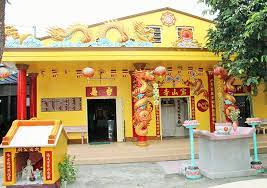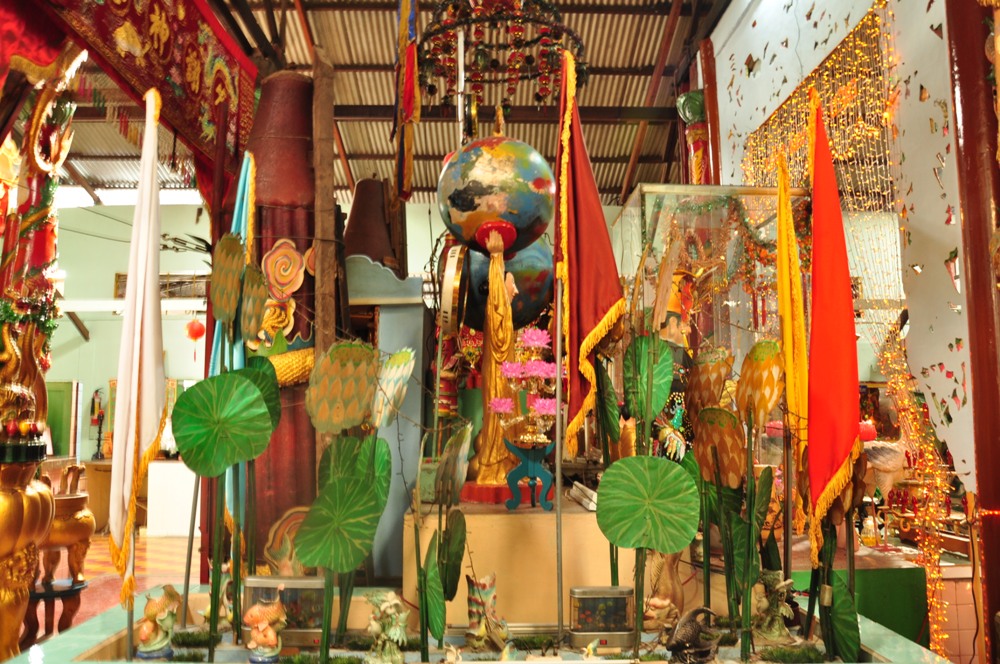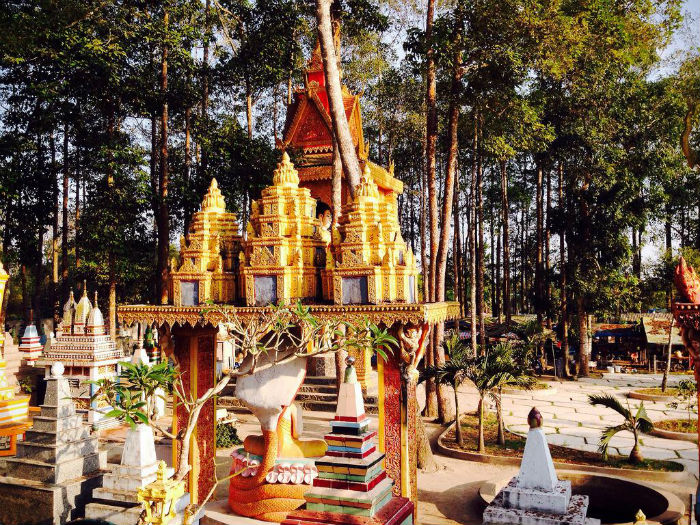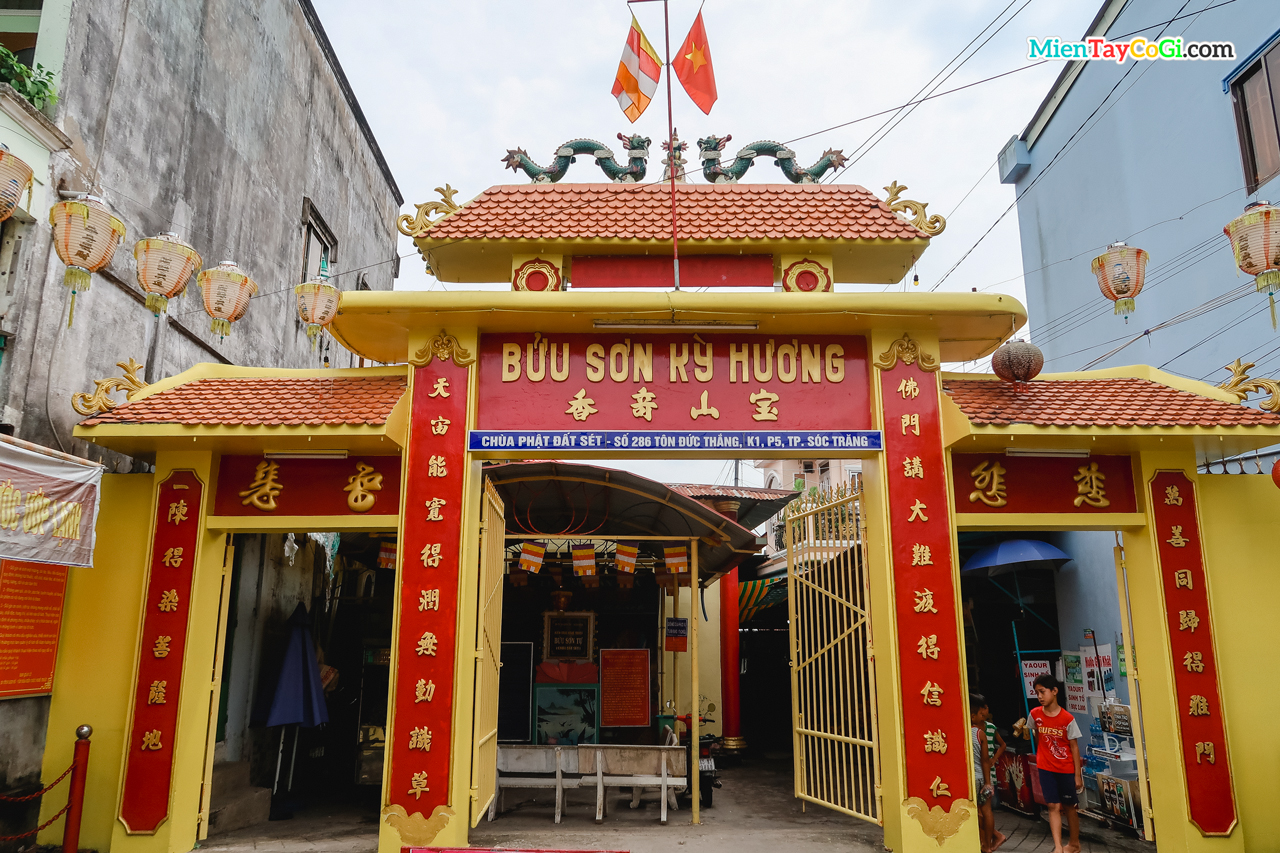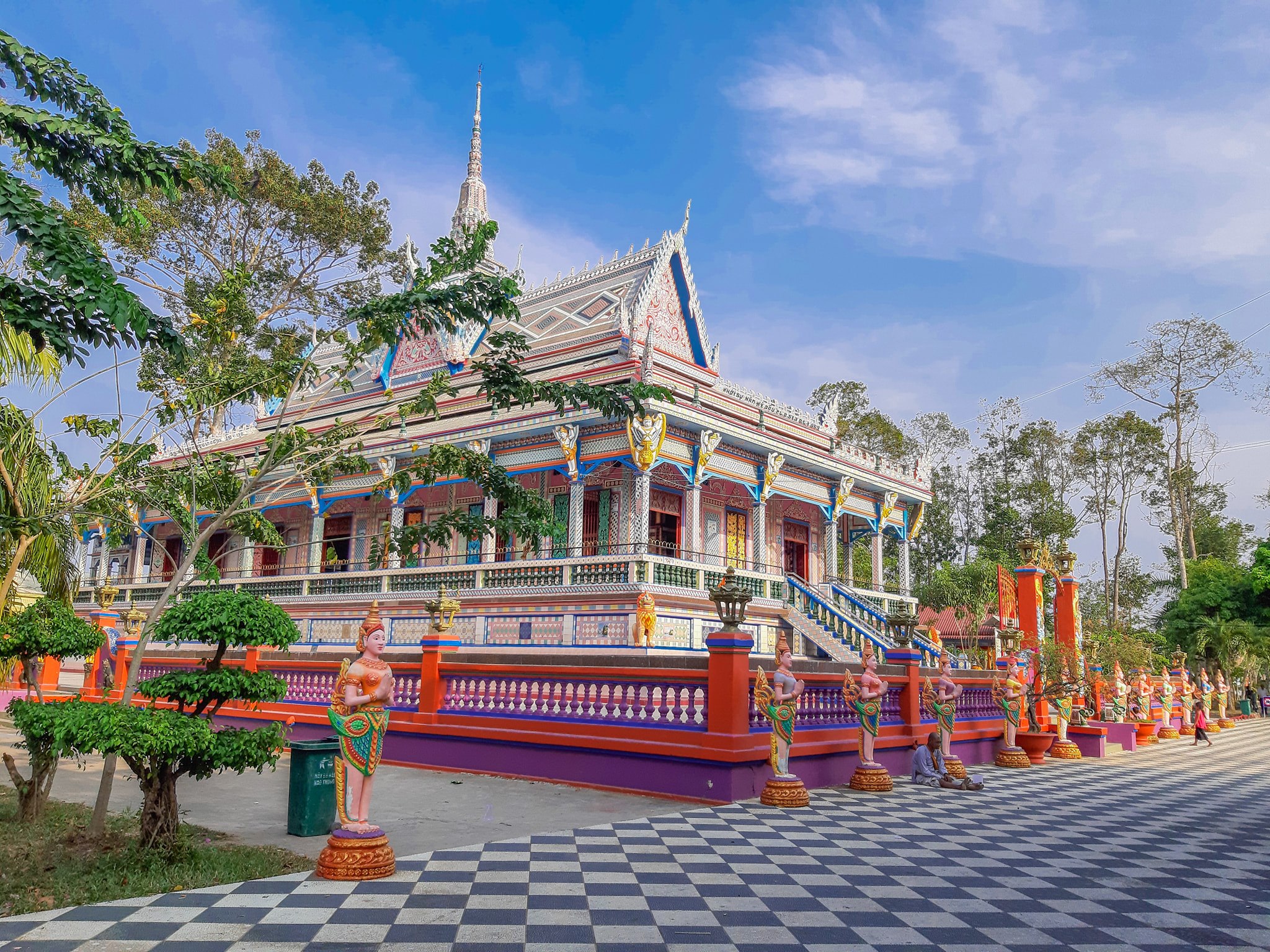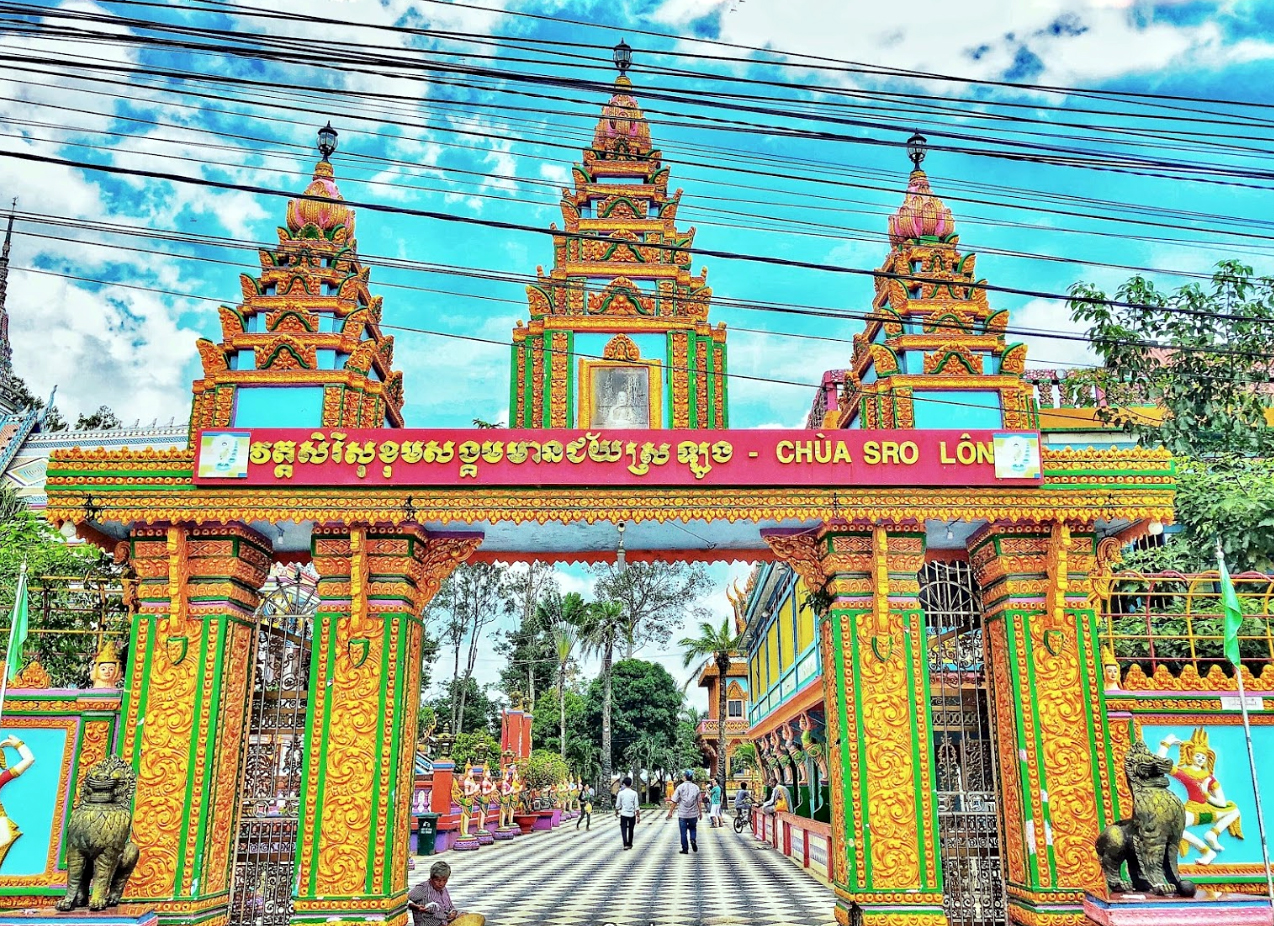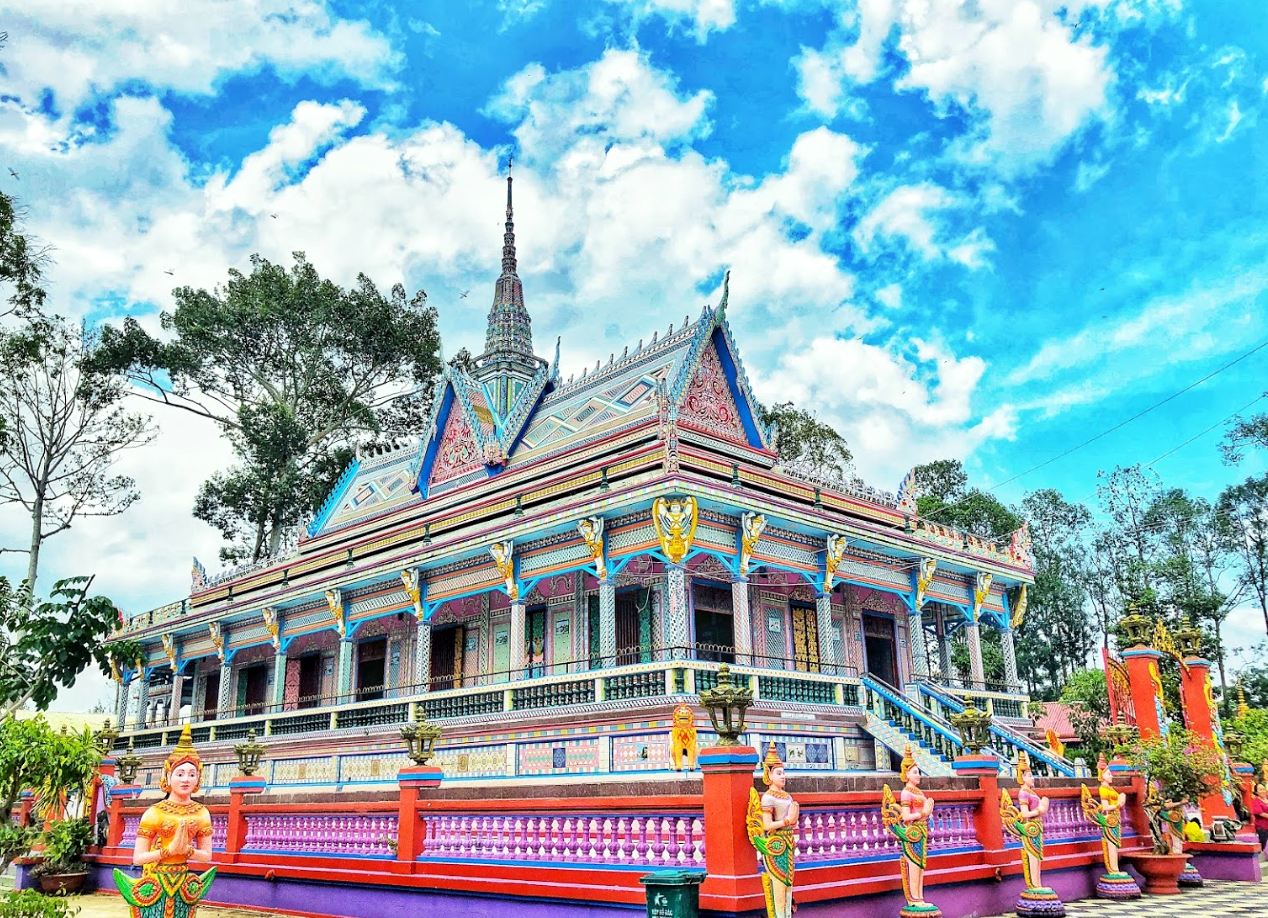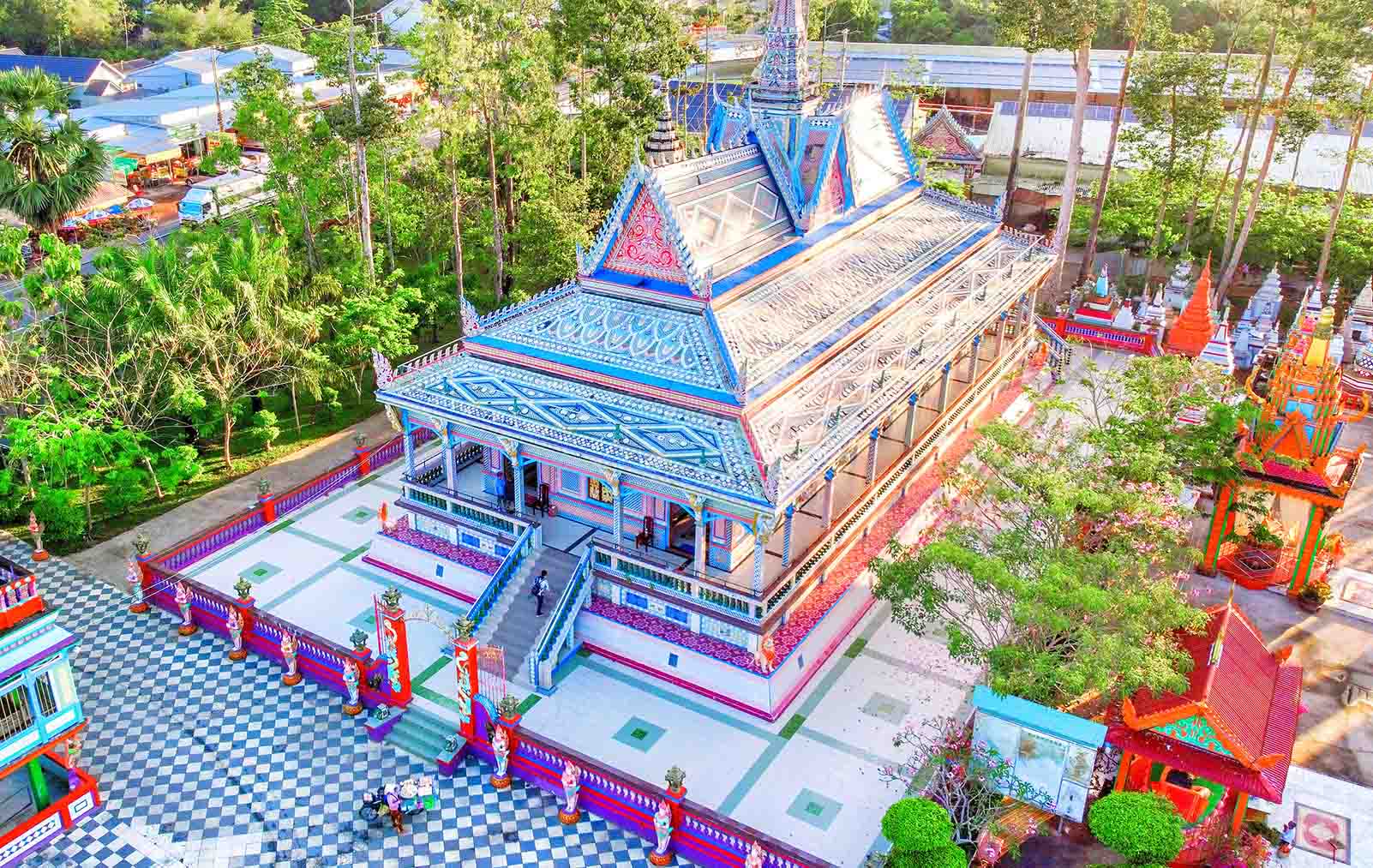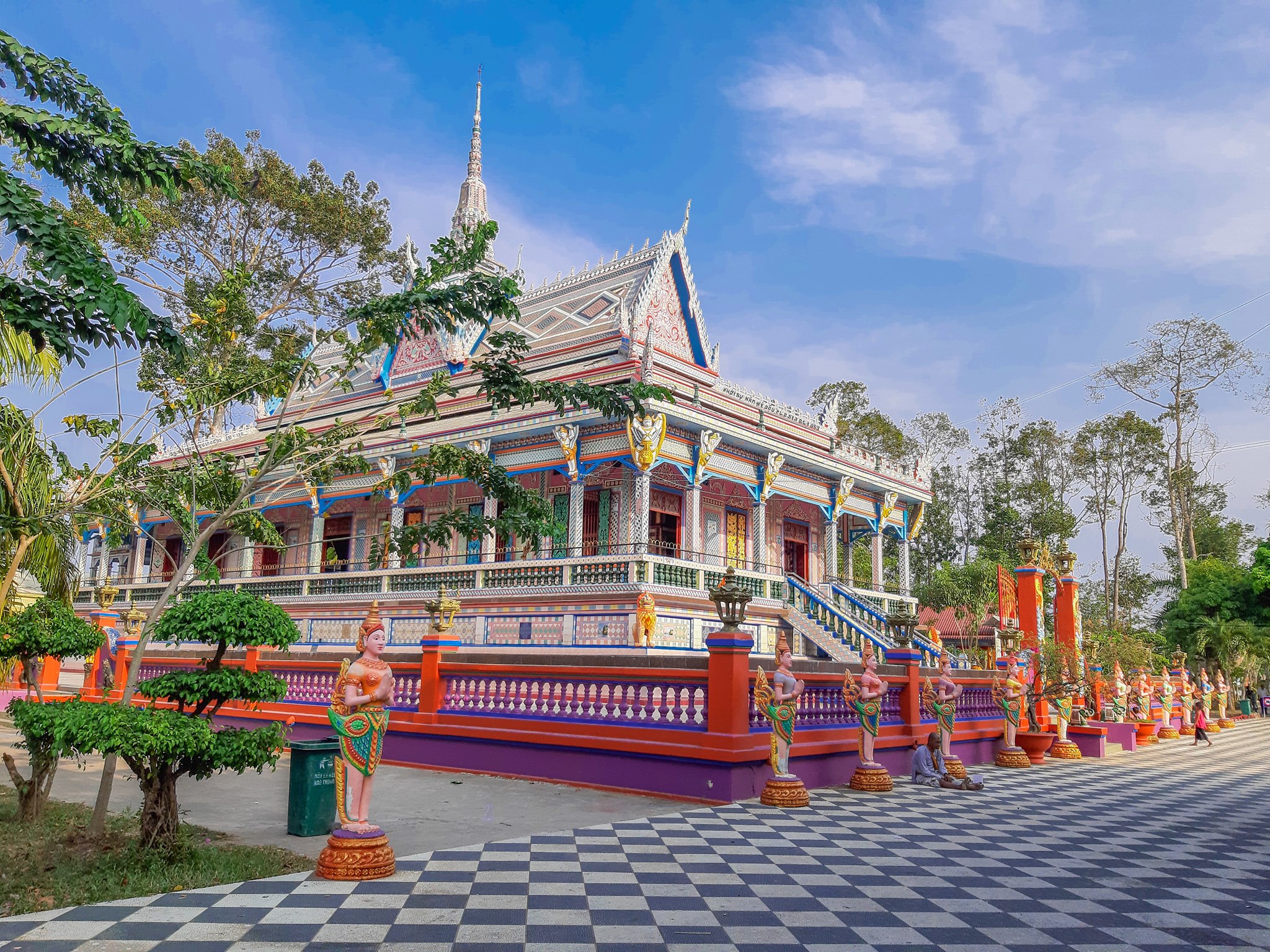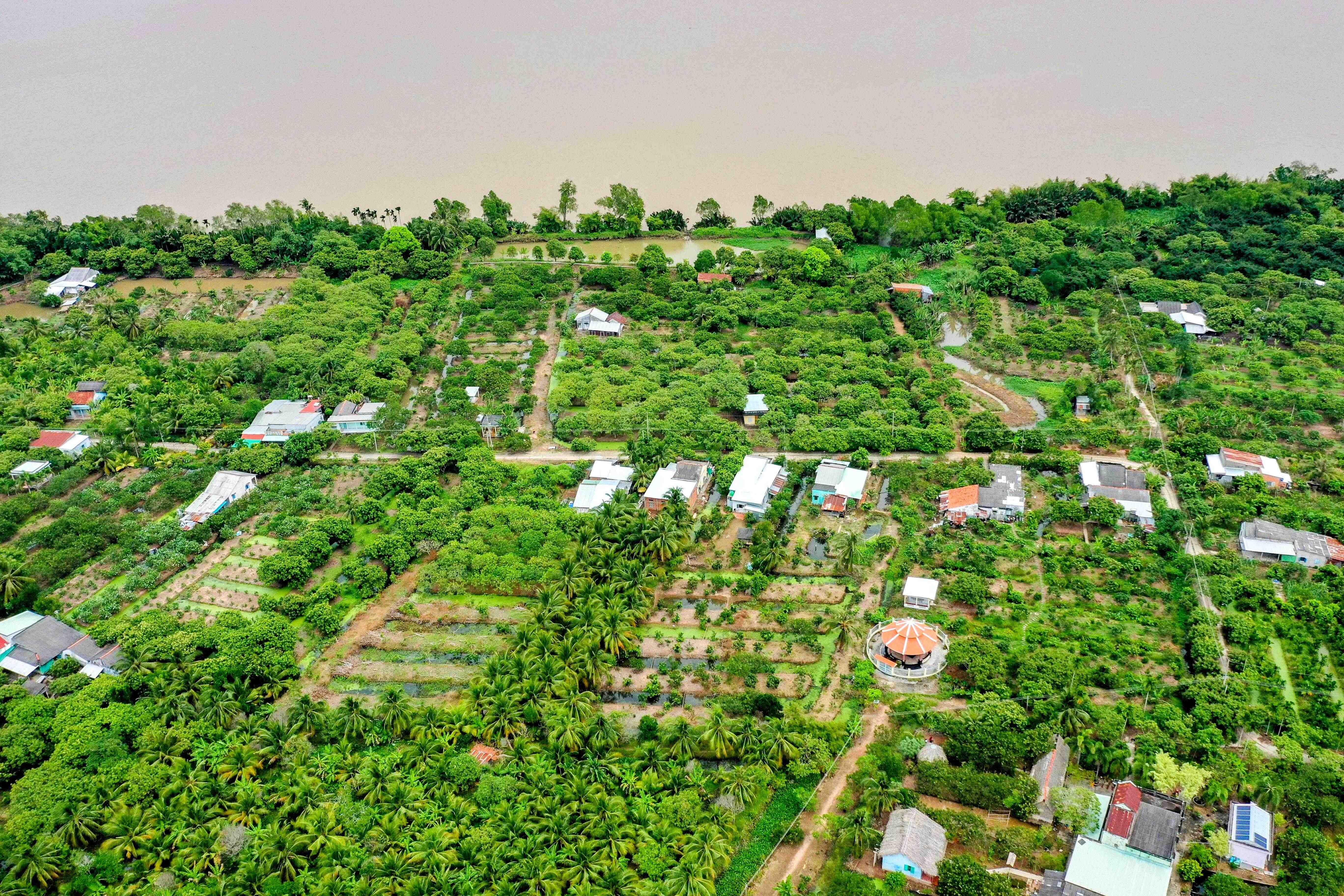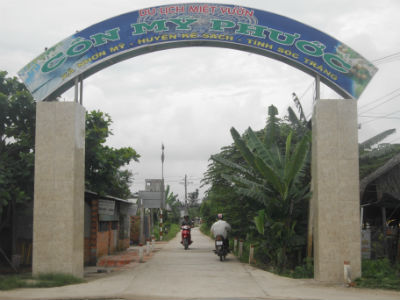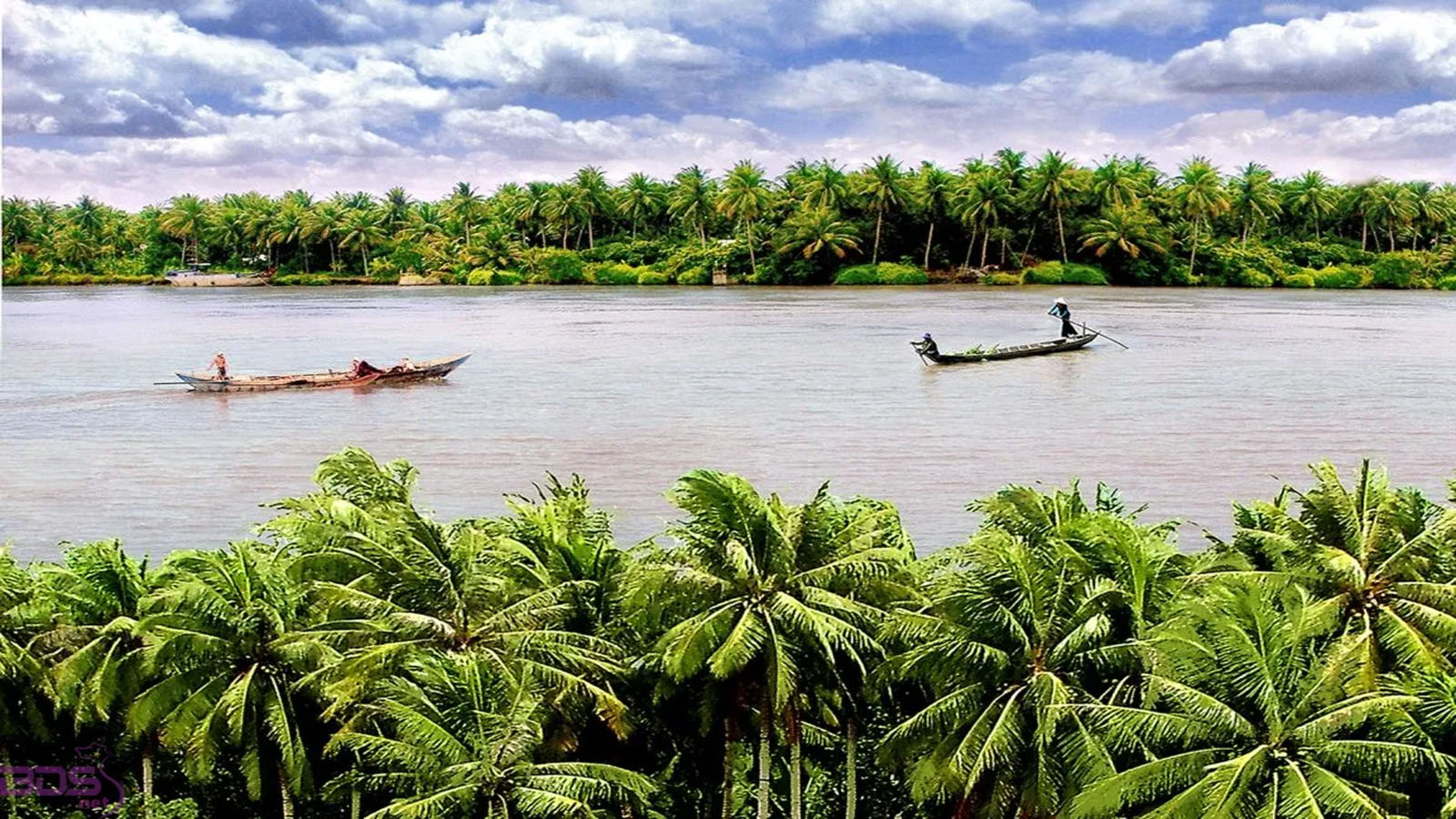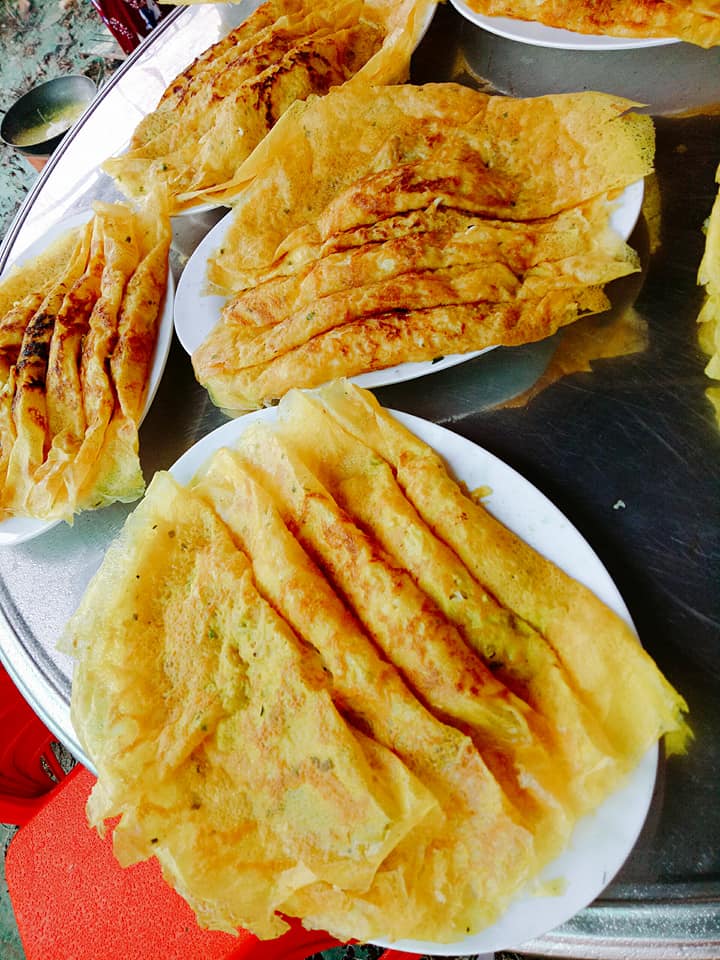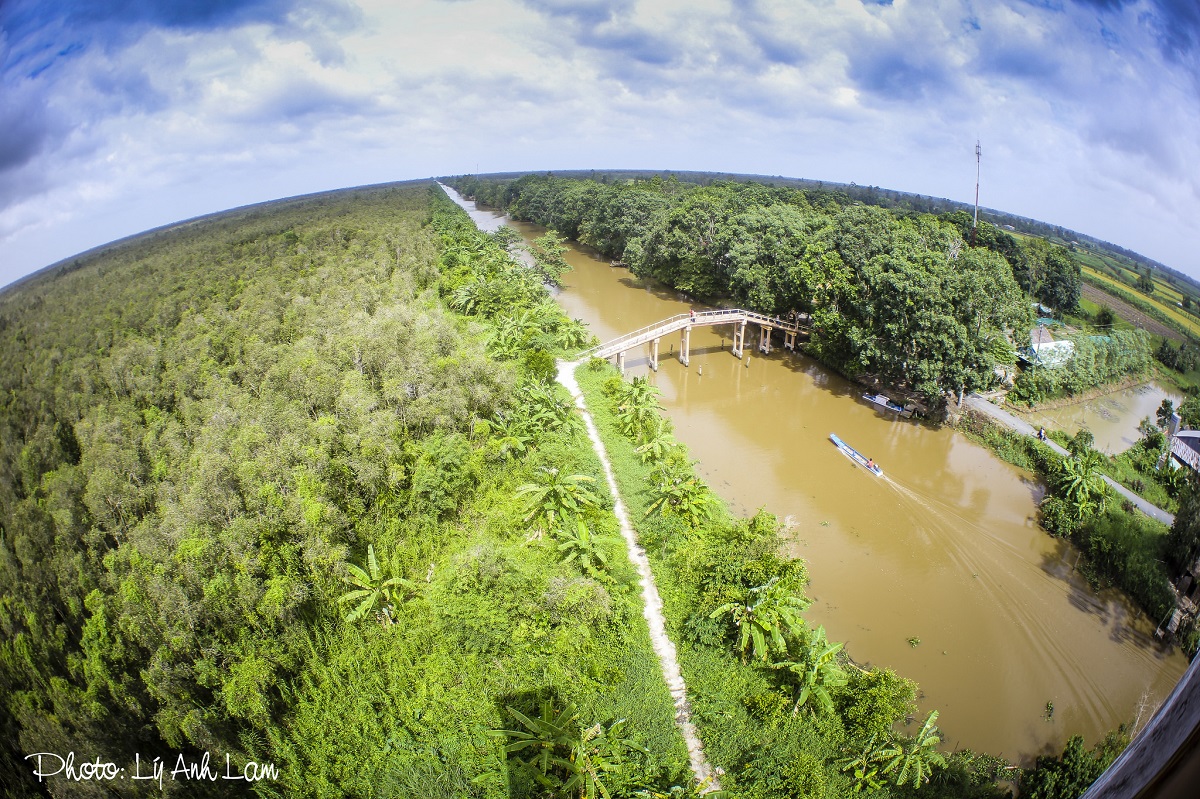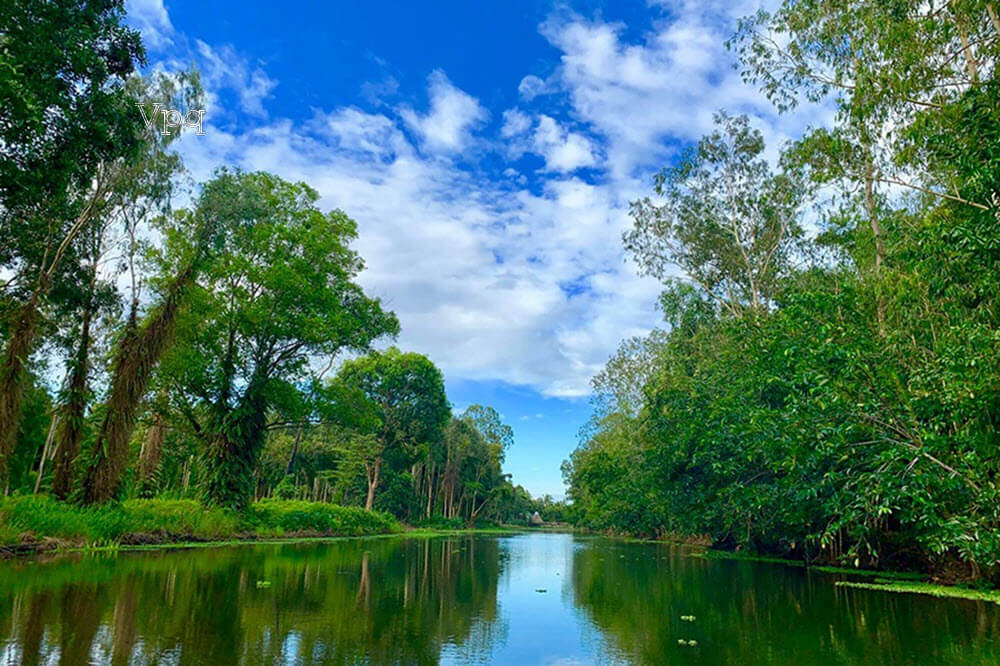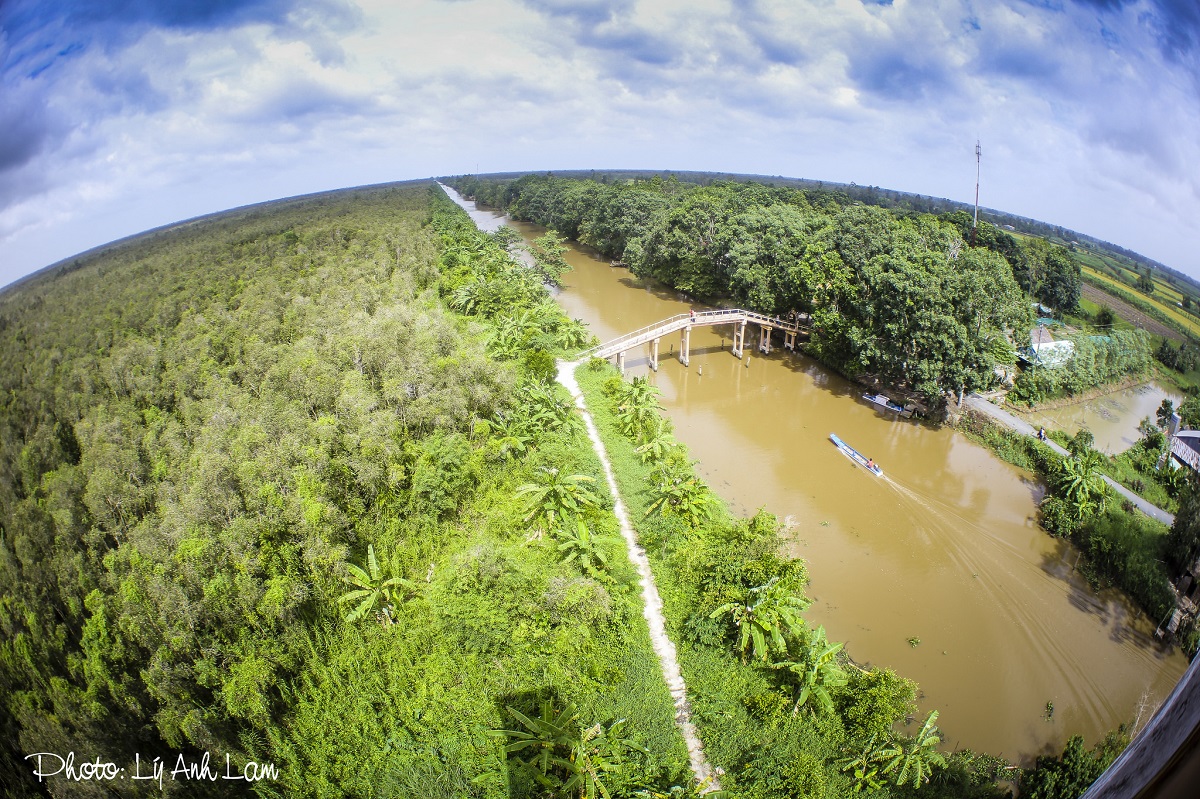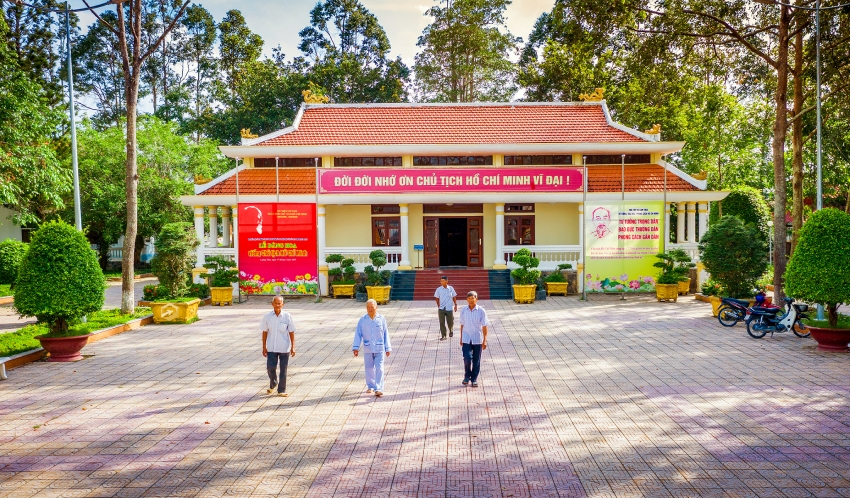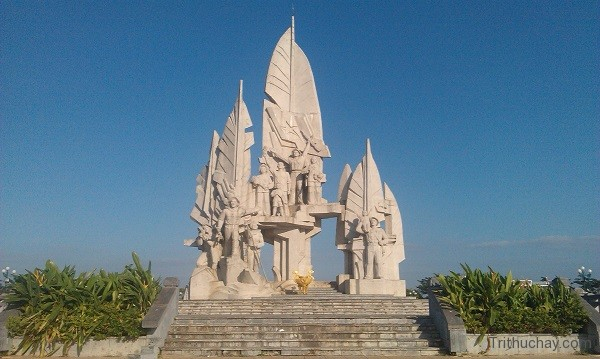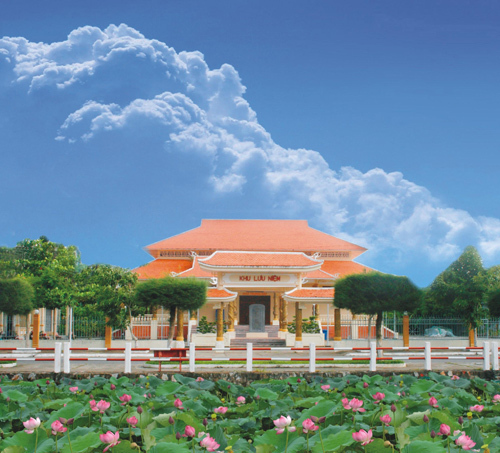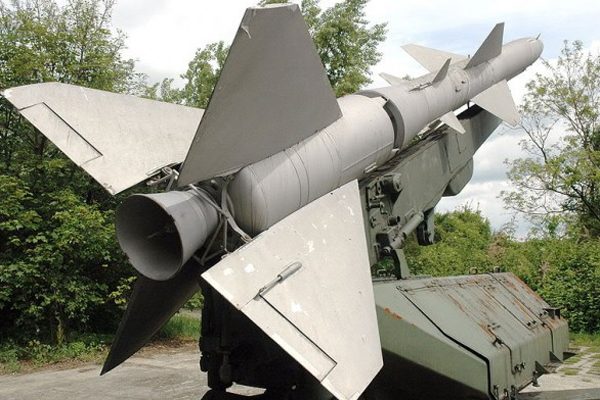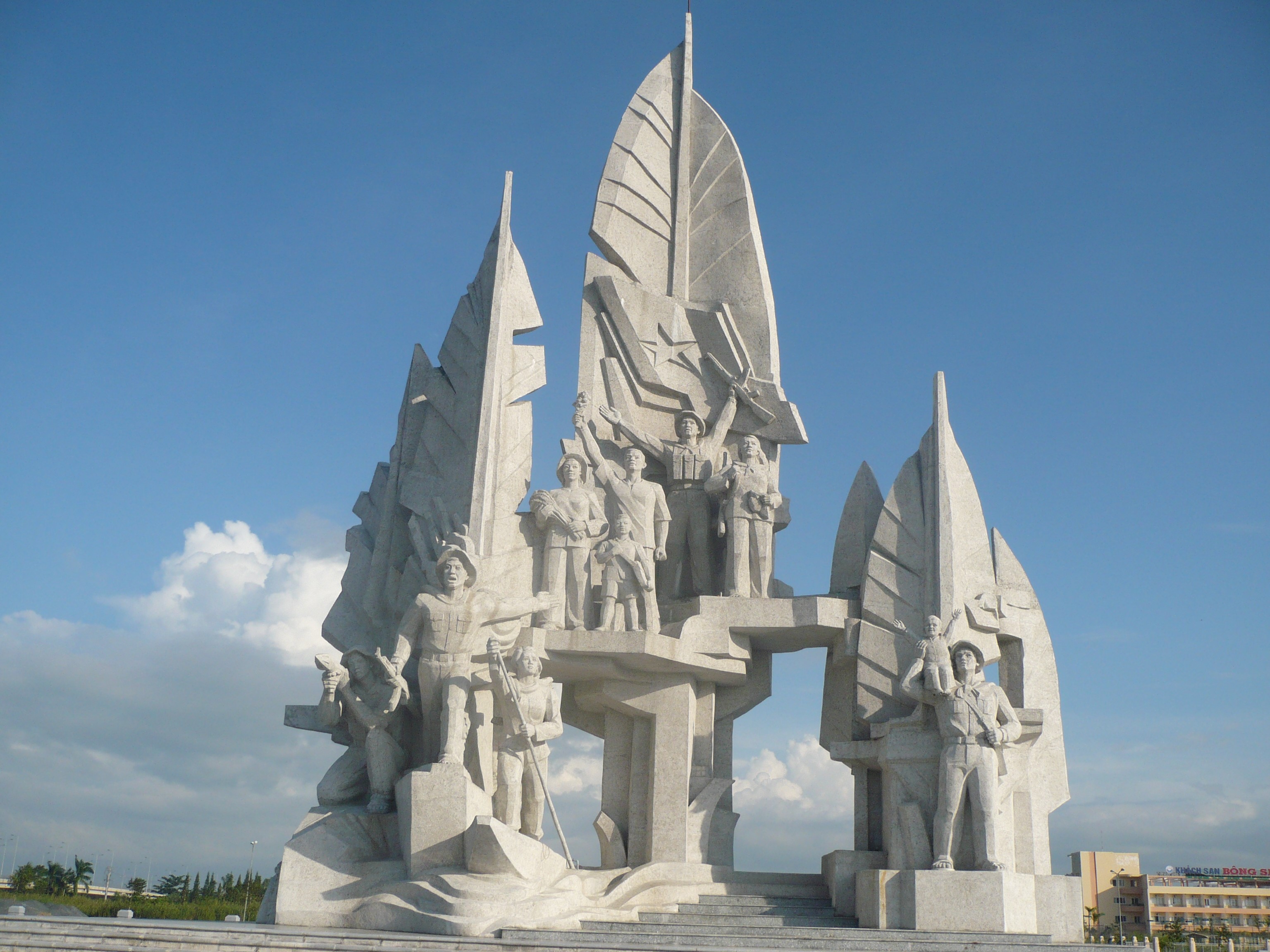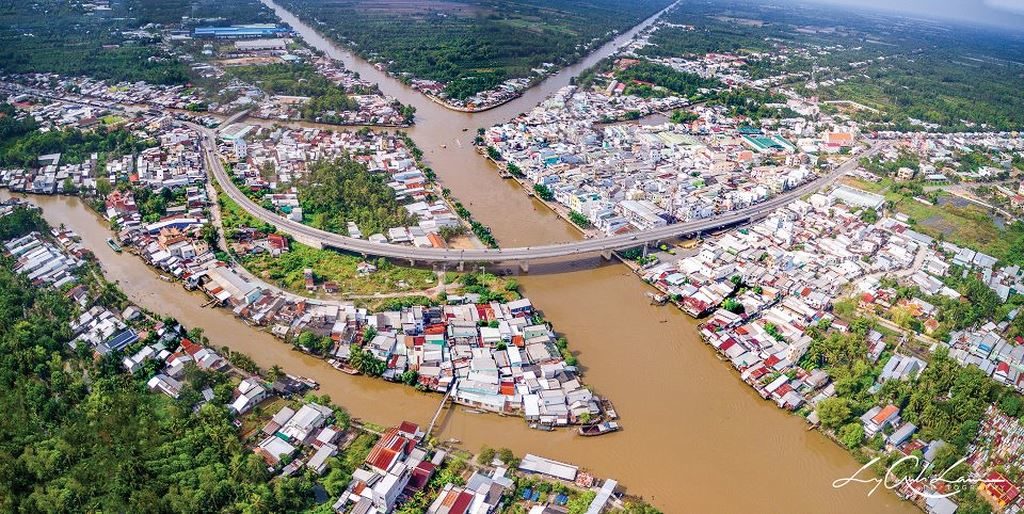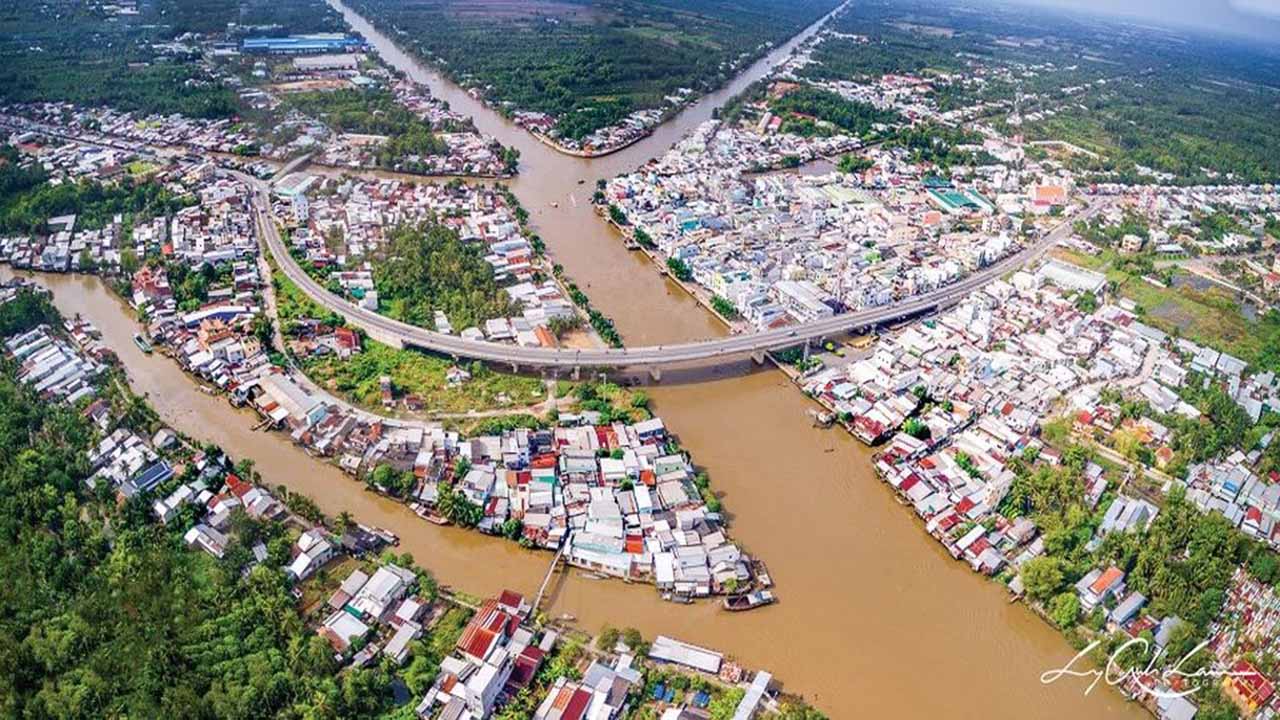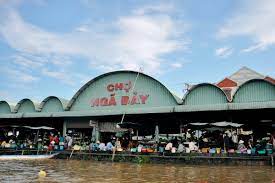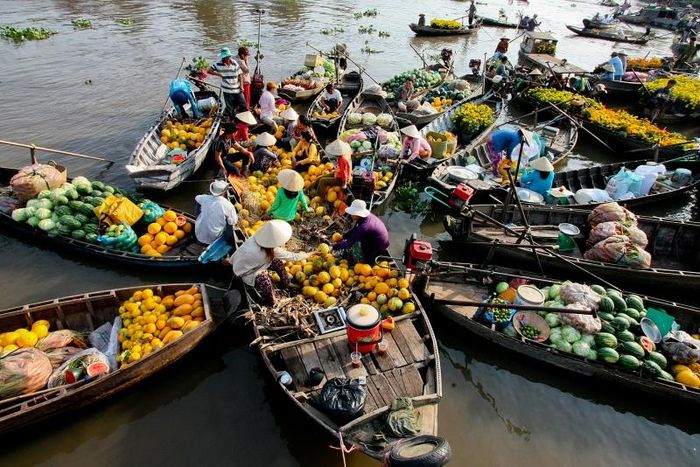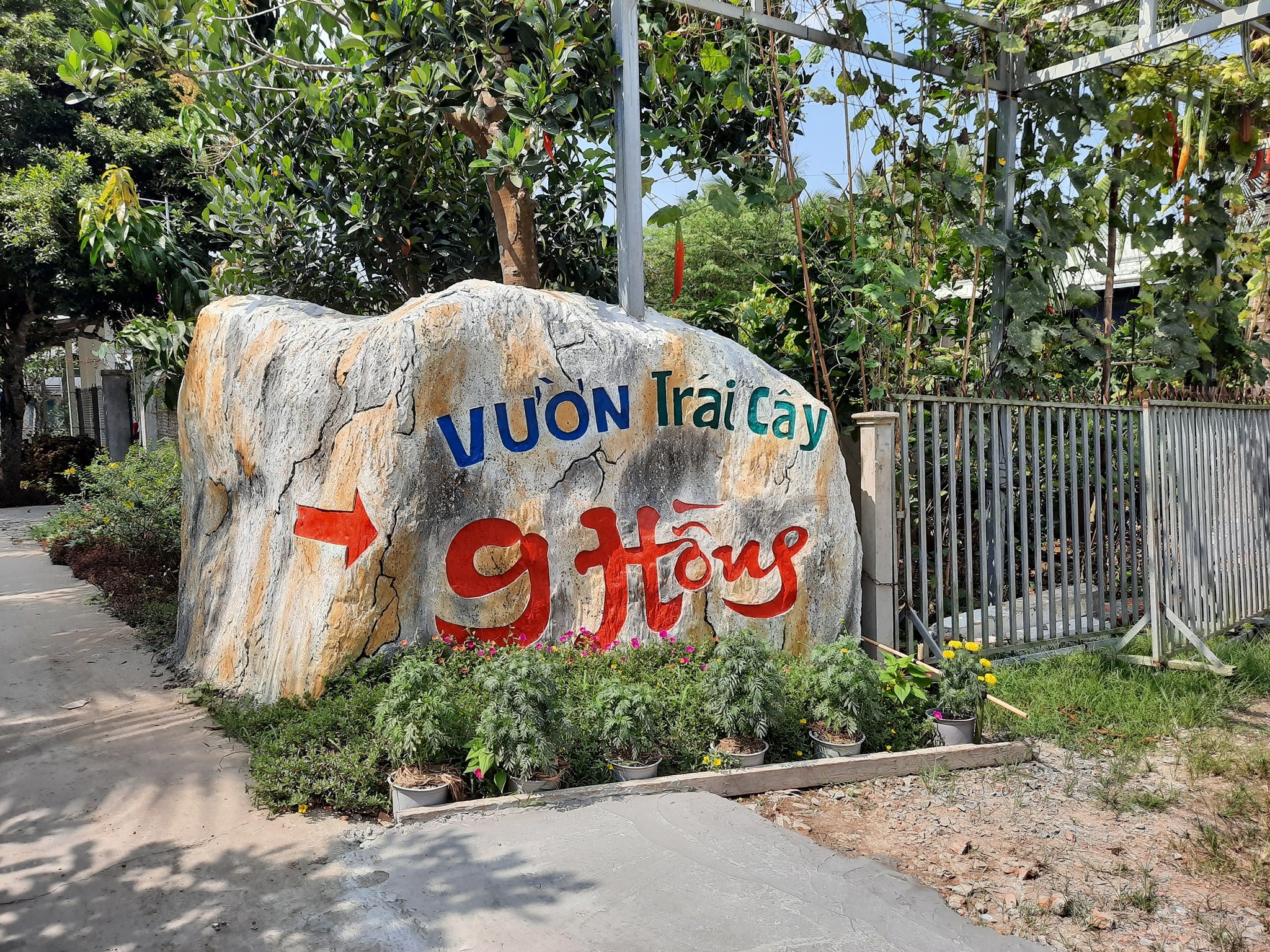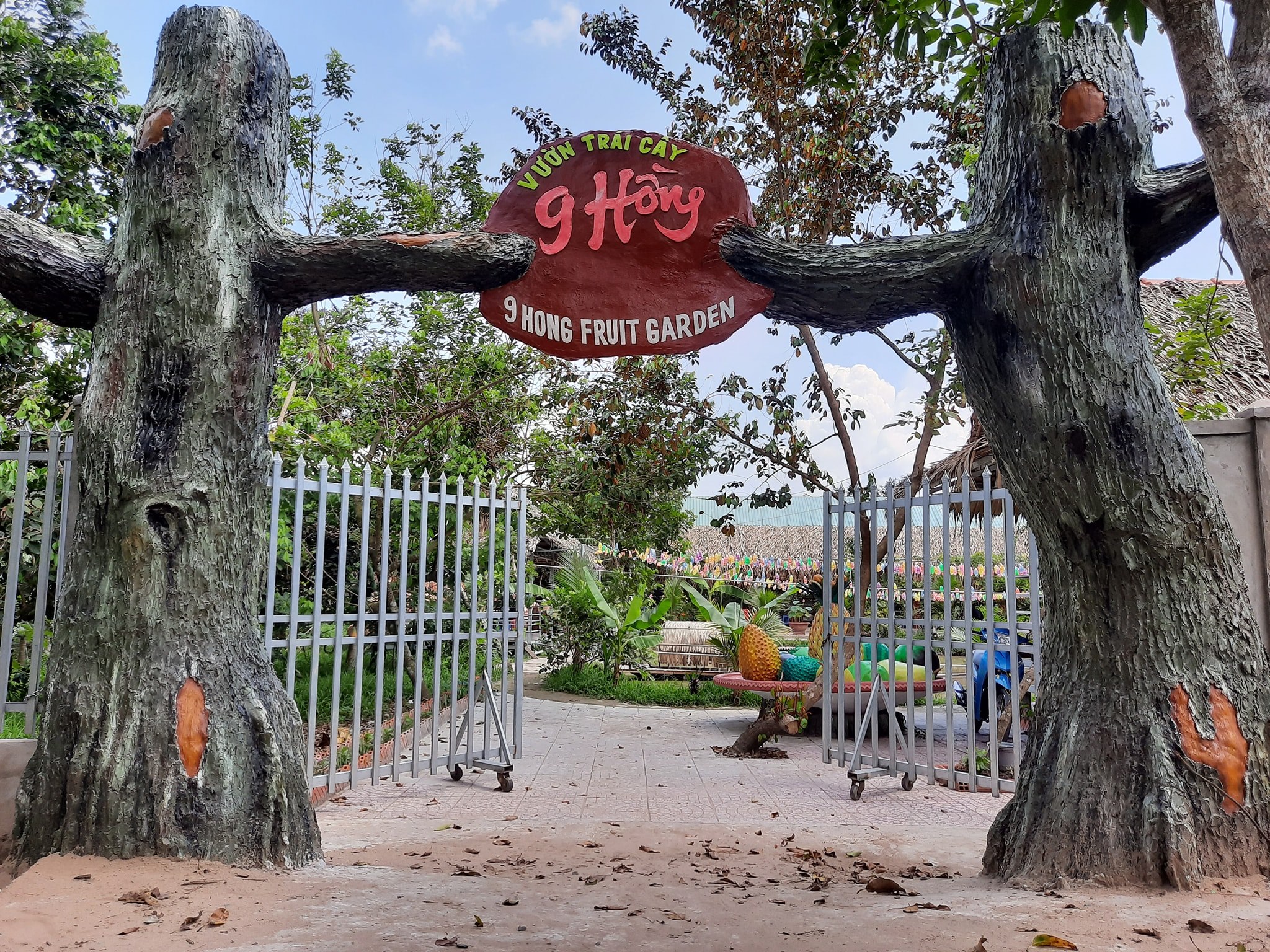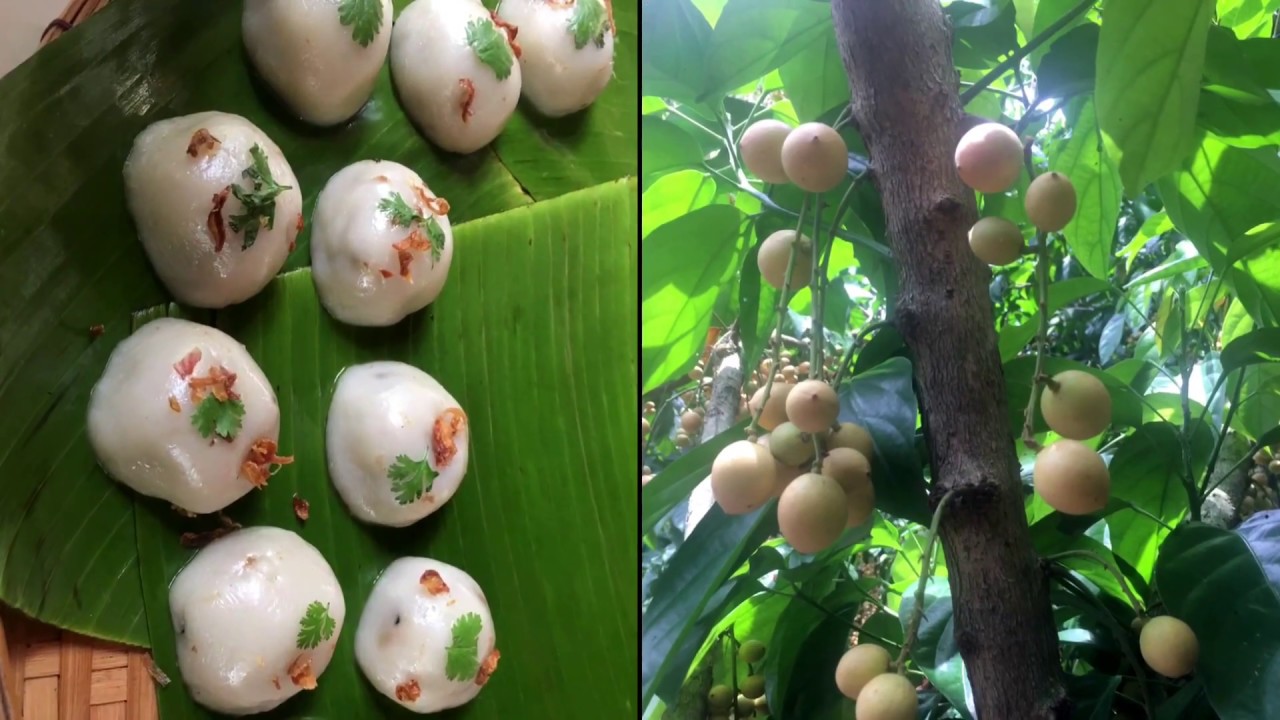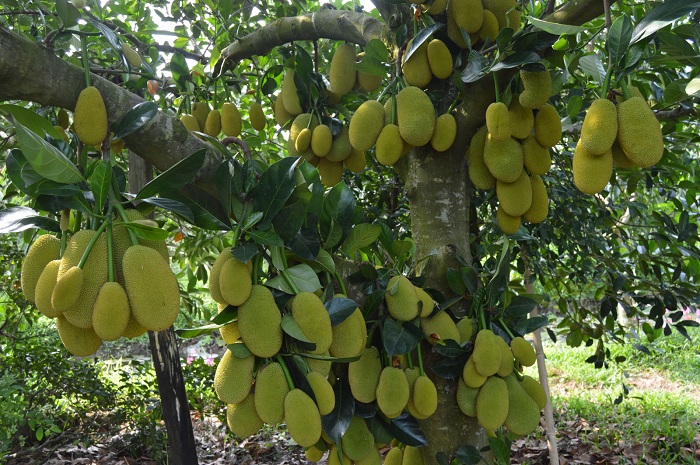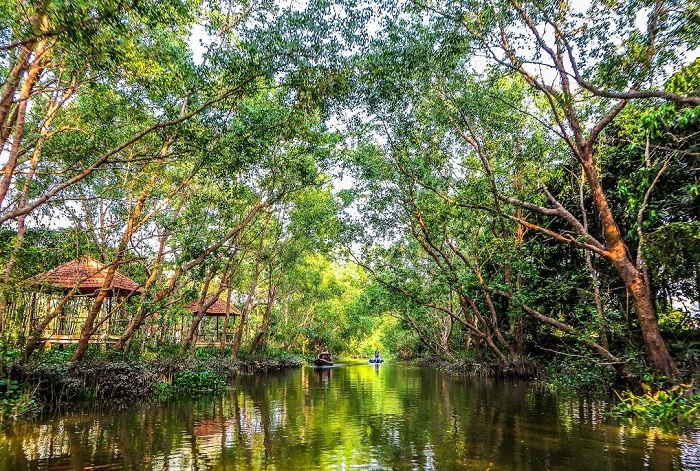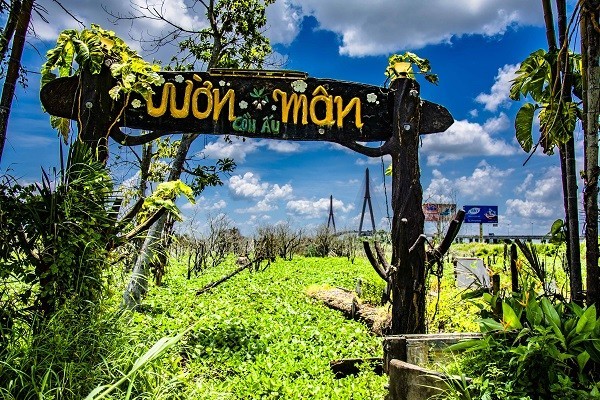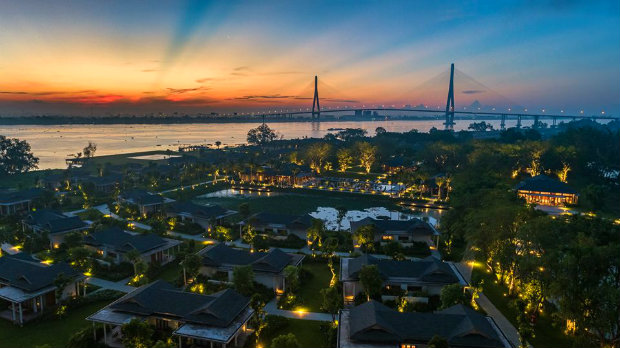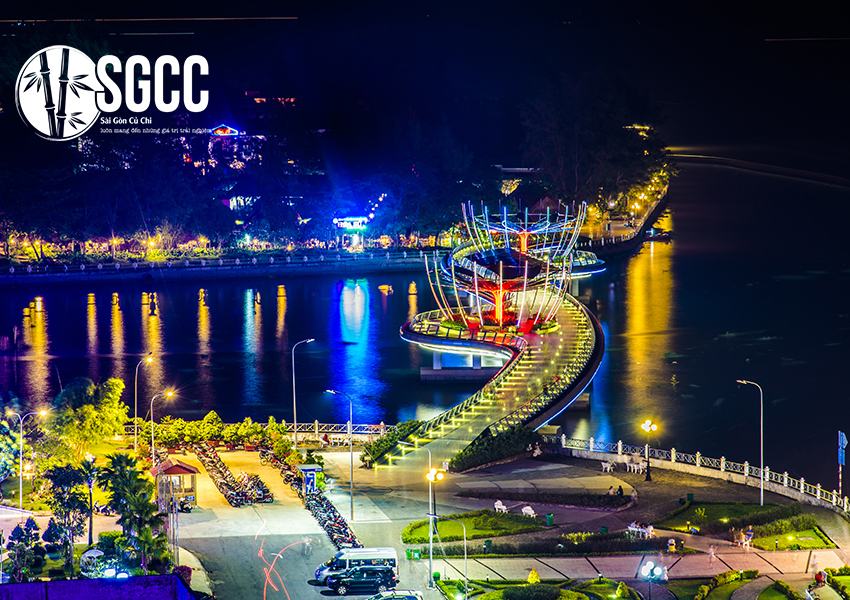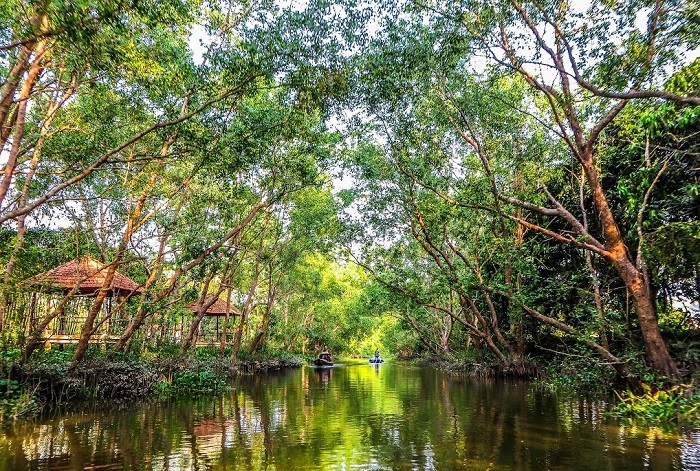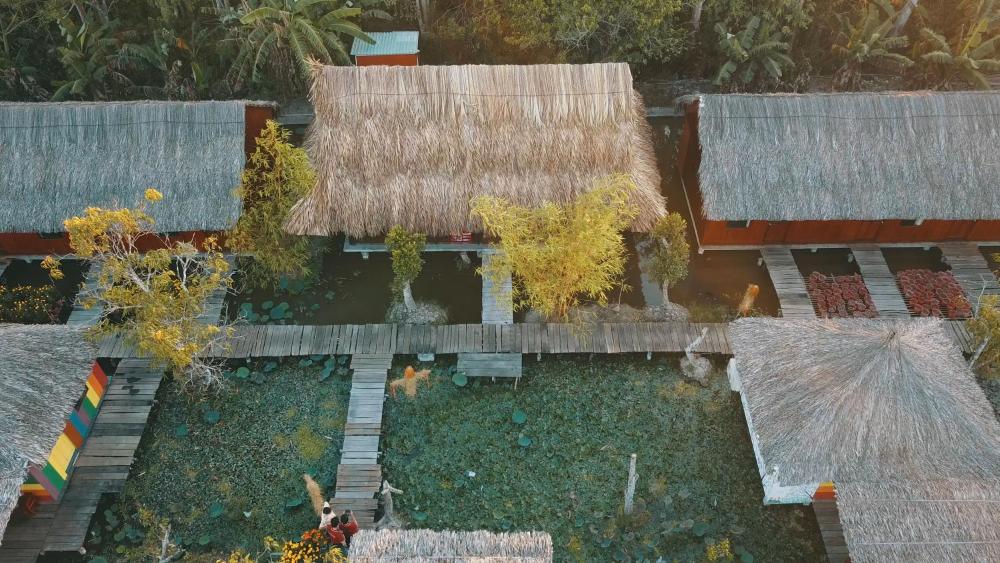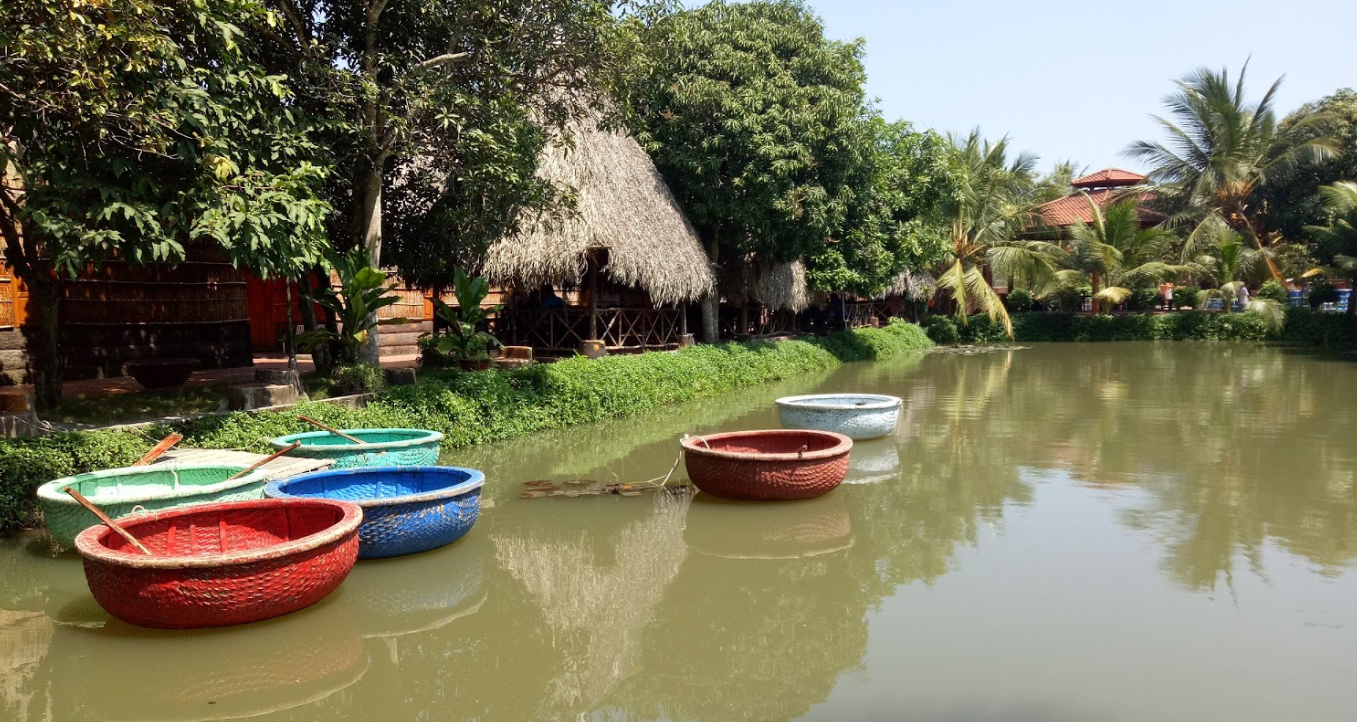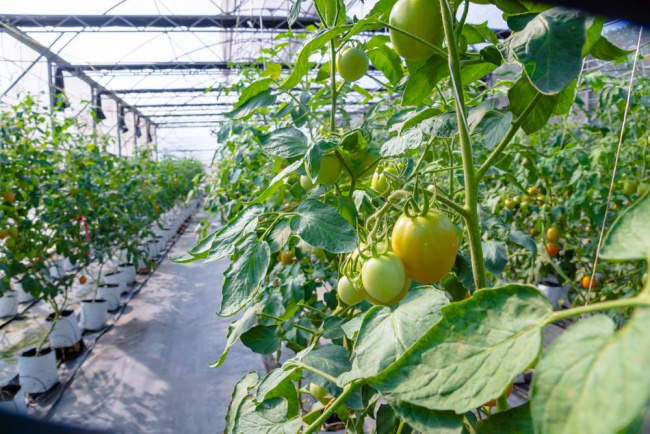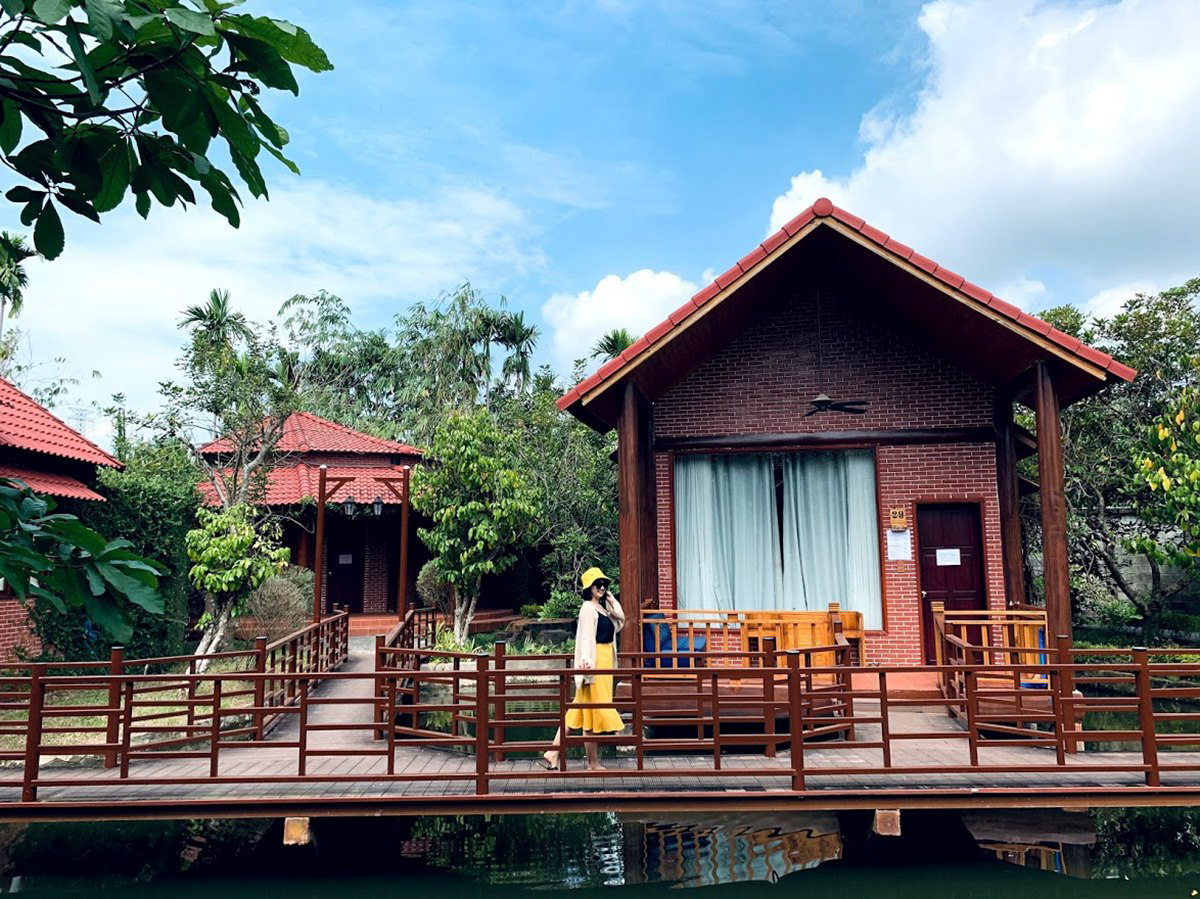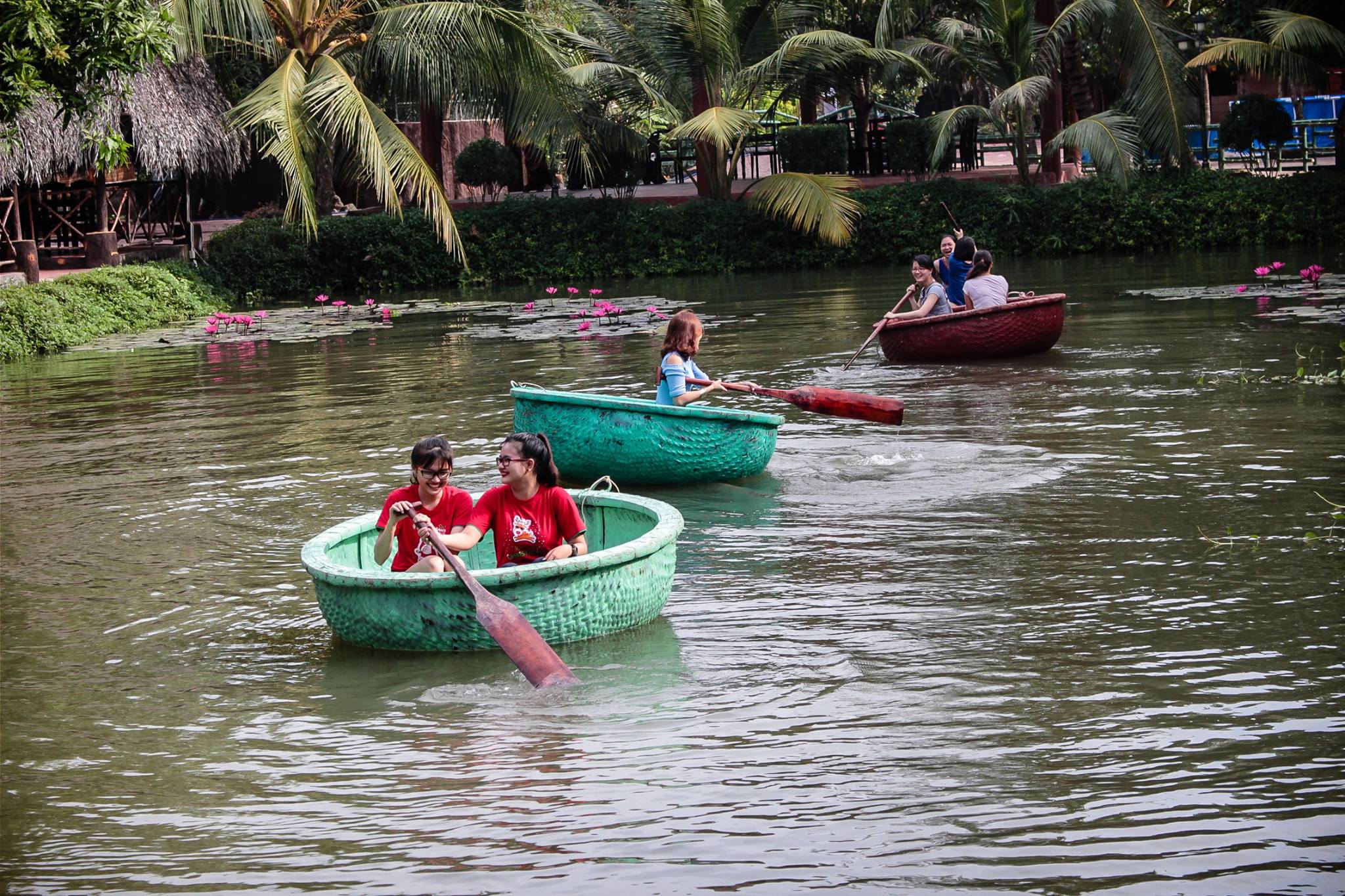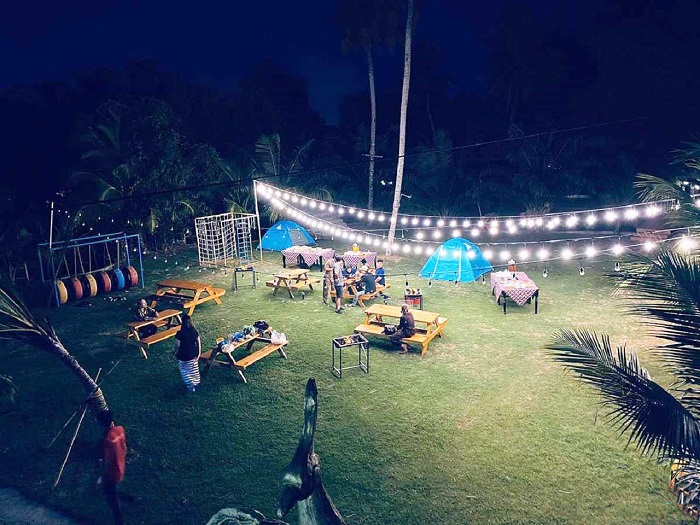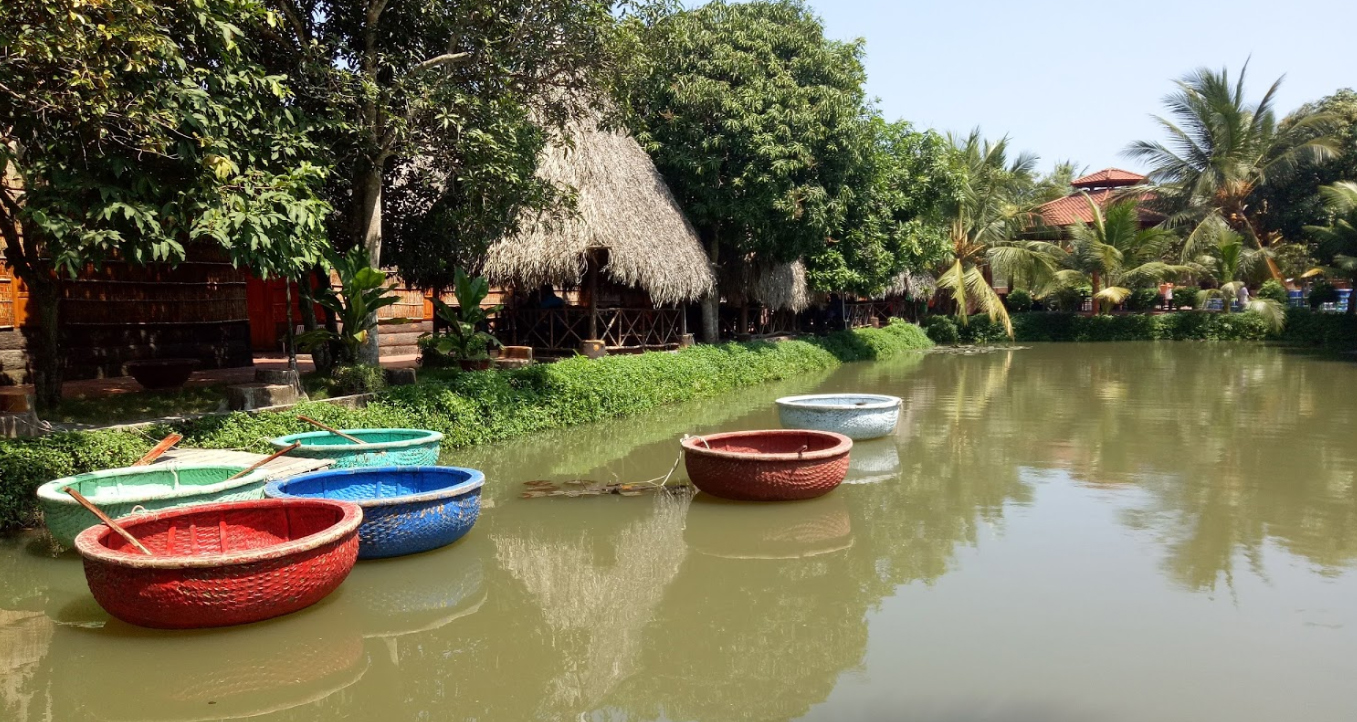Tourist destination
Na Hang tourist area
If you have the opportunity to visit Buu Son Tu, visitors will have the opportunity to learn about the unique cultural, spiritual and religious life of the people of Soc Trang. Buu Son Tu, also known as Clay Pagoda, is located at 286, Ton Duc Thang Street, Group 1, Ward 5, Soc Trang City, Soc Trang Province. Clay Pagoda is not famous for its external architecture or large scale in area, but it is a unique pagoda in Vietnam because thousands of artifacts inside are shaped from clay and made from clay. There are pairs of candles and giant incense sticks. According to the elders, Buu Son pagoda was previously just a small hermitage built around the beginning of the 19th century, built by Mr. Ngo Kim Tay for the purpose of practicing at home. At first, the pagoda was made entirely of available natural materials such as bamboo, paintings, etc. It was not until the fourth abbot, Mr. Ngo Kim Tong (1909 - 1970), that the small temple was renovated and expanded. to have Buu Son throne like now. Buu Son pagoda has an area of about 400m2 with traditional architecture of wooden columns and corrugated iron roof, but this ancient pagoda contains many unique cultural and artistic values. There are nearly 2,000 large and small Buddha statues, along with sacred animals and worship objects, molded by artist Ngo Kim Tong in clay for 42 years (from 1929 to 1970). Traveling to Soc Trang, visiting Clay Pagoda, everyone admires and admires the genius who used his lifelong determination and love for Buddhism to create this miraculous work. Mr. Ngo Kim Tong is the son of Mr. Ngo Kim Dinh. When he was young, he was often sick. In 1929, when he was 20 years old, he fell seriously ill and thought he would not survive. The family had no choice but to take Mr. Tong to a mountain temple in An Giang province for treatment and to pray to God and Buddha. While taking medicine and practicing meditation and calming down, he gradually got better. Mr. Ngo Kim Tong became a monk and returned to the temple to become the fourth generation abbot, an artist who did not go to sculpting or painting classes, did not study with a formal teacher, but only through folk contemplation created amazing works. Clay sculptures have extremely rare religious historical value. The raw materials used for making statues are mainly clay, dug by Mr. Tong from fields a few kilometers away from the pagoda, brought back to dry, then put in a mortar and pounded with a pestle until smooth, filtering out all impurities and roots. trees, grass roots, take fine soil and mix it with sawdust to make incense (incense powder) and acacia acacia to create a fragrant mixture. At that time, he just started shaping the statues. The statues were smooth and not cracked. In addition, he also researched and applied support methods for sculpting statues to meet high aesthetic requirements. He used wire mesh and wooden trees to build the ribs, then used mosquito net fabric to cover it and covered it with mixed materials to make the statue. , the exterior is covered with a layer of metallic paint and varnish. Not only with his skillful and talented hands, but also with his extremely rich imagination, hundreds of large and small statues were formed without duplication. Each statue has a different look, clearly showing the spirit on each face. It is also the result of the mind of a Buddha-oriented person, the diligence, diligence, and quietness that brings sweetness to life. Mr. Ngo Kim Tong also created other works, the most prominent of which is the Da Bao tower built in 1939 when he was only 30 years old, about 4 meters high and very sophisticatedly designed. The tower has 13 floors, each floor has 16 doors, each door has a Buddha statue, in total Da Bao tower has 208 doors, 208 Buddhas and around the tower there are 156 winding dragons flying into the sky. tall, protecting the tower. Bao Toa is the second unique building built in 1940, about 2 meters high. Above there is a lotus flower with 1000 petals in an octagonal shape, below there are 16 fairies standing as attendants. The base of the tower is shaped like 4 animals of the four sacred animals (unicorn, dragon, tortoise, phoenix) and 12 unique, lively and impressive fish transformed into dragons. Looking at this tower and lotus flower as a whole, visitors will immediately think of a talented sculptor who took advantage of Buddhist teachings to create statues that speak the Buddha's meaning. In the worship space above the ceiling, there is hanging a chandelier called "Luc Long Dang" also made of clay, consisting of three peaks with 6 curved dragons symbolizing the six provinces of the Southwest region, their tails bunched together. each other, heads sticking out in all directions. The dragon's body is made entirely of clay with many delicate details, so the weight is quite heavy. At the bottom of the lamp is an upside-down lotus that radiates its petals to the altar. The lotus petals are quite thin, but according to the passage of time, Luc Long Dang has not fallen or chipped at all. This is a rare artistic masterpiece and the last work of his life. Around the pagoda, contributing to guarding the system of Buddha statues, there are many animal statues also made of clay. The most prominent and sharpest is the pair of Kim Lans holding their heads high in front of the altar in the middle of the hall, holding pearls in their mouths. The feet resting on the ball look so majestic, plus the statues of Thanh Su, Bach Ho, Long Ma,... some are gentle and some are very majestic. Clay Pagoda is not only famous for its thousands of statues made of clay, but is also known to tourists for its four rather special pairs of giant candles. In the last years of his life, he temporarily stopped making statues and cast candles to erect them in the main halls of the temple. He bought pure, unadulterated wax from Saigon many times with his trusted disciples, chopped the wax into pieces, melted it, and then "cast" the lamp. Because these lamps were too large, Mr. Ngo Kim Tong could not find a suitable mold, so he used roofing iron to make the mold. Pour wax into a large pan and cook continuously for many days until the tube was full until noon. 2 meters high. After a month, the new pairs of candles were completely dry. When the mold was removed, these pairs of lamps naturally took on the wavy shape of corrugated iron sheets. After several months of continuously doing this, he was able to cast six large candles (3 pairs). ), each weighs 200 kg, each pair is estimated to burn continuously for more than 70 years and two small candles each weigh 100 kg. The pair of candles was lit on the full moon day of July 1970 since the day Mr. Ngo Kim Tong The tree has been burning continuously for more than 40 years and nearly 1/5 of the tree remains. The works made from clay created by Mr. Ngo Kim Tong more than 60 years ago are still intact over time. However, what all tourists and scientists cannot explain is that all of the most famous and strange works in the world were created by a monk. I just finished 3rd grade at the village school and don't know anything about the art of painting.
Can Tho
From January to December
3936 view
Na Hang tourist area
Located in the Southern Khmer pagoda system in Soc Trang, Chen Kieu Pagoda is known as one of the pagodas with a "unique" architectural style that leaves a deep impression in the hearts of visitors. The outstanding feature of this temple is the walls. It is not evenly cemented, tiled or painted like other temples. The walls of this temple are covered with pieces of cups, plates, and ceramics that look very unique but extremely beautiful and aesthetically pleasing. Chen Kieu Pagoda, also known as Sa Lon Pagoda, is located in Dai Tam commune, My Xuyen district, Soc Trang province, located right on National Highway 1A, about 12 km from Soc Trang city, in the direction from Soc Trang city to Bac Lieu. The pagoda's Khmer name is Wath Sro Loun. For ease of pronunciation, the word Sro Loun is spelled Sa Lon. Sro Loun originates from the word Chro Luong - the name of a canal running along the village road that used to be near the pagoda, and that name is also used to name the pagoda. In 1815, Chen Kieu Pagoda began to be built with materials like leaves, wood, soil... like many other Khmer pagodas. During the war, under the devastation of bombs and bullets, the main hall of the pagoda was seriously damaged. In 1969, the pagoda was rebuilt according to today's architecture, including: Main hall, sala, stupa, place for prayer books, etc. During the construction process, due to lack of materials, the monks came up with an idea. The idea is to donate cups and plates from people in Phum and Soc to put on the wall. This idea not only saves construction costs but also creates impressive decorative motifs. Since then, the pagoda has also been known by the people by its second name: "Chen Kieu Pagoda". Khmer artisans cleverly took advantage of these cups and plates to decorate the walls and towers, creating a harmonious and impressive architectural work. New items are placed directly on the wall, or made into convenient fences surrounding hallways or stair handrails, while broken or chipped items are arranged and assembled into decorative patterns. fancy. The first impression when entering the temple is the three-entrance gate with three towers carved with vibrant patterns and colors in the traditional Cambodian Angkor style. Among the three towers, the middle tower stands out with a glass cage inside, enshrining a majestic sitting Buddha statue. Surrounding the pagoda is a fence decorated with the image of the dancing goddess Apsara, symbolizing peace and prosperity. On both sides of the entrance gate are two stone lion statues, facing the street as if protecting the temple. On the gate wall are the words Khmer and national language: "Sa Lon Pagoda (Chen Kieu)". Along the entrance to the pagoda are two rows of statues of the god Kayno (kerno), these are statues with the face of the fairy Apsara - symbolizing eternal beauty and the body of the god Garuda - symbolizing strength. The campus of Chen Kieu Pagoda is very large with many cool green trees, making visitors feel very comfortable. Like other Khmer pagodas, the roof of Chen Kieu Pagoda consists of 3 staggered roofs, the top roof being the smallest. At the edge of each roof layer there are decorative patterns, motifs, and traditional statues of Khmer culture, carrying the wish for peace and escape. The triangular roof is beautifully decorated like a colorful carpet exposed to the sky. The two ends of the knife on both sides are curved as if there is a spiritual communion with the savior of human souls, blessing and protecting sentient beings for peace and happiness. The most outstanding and impressive architecture on the facade of the main hall is the column heads decorated with the image of the winged goddess Kayno. These statues of the goddess Kayno are in a rising position to support the roof's fringe, creating a transition between the vertical direction of the columns and the horizontal direction of the roof. The main hall of the pagoda is spacious and airy, with 16 rows of large columns. Around the pillars are carved and embossed with images from Khmer cultural legends. On both sides of the wall are many paintings telling the story of Shakyamuni Buddha from birth until attainment of enlightenment. The walls and paintings are even more special when decorated and shaped with broken pieces of cups and plates. The worship space is a complex of 20 large and small Buddha statues, with many standing, lying, and sitting positions, arranged reasonably and artistically. The smoke of incense and the light of candles swaying with each gentle breeze make the already solemn temple even more solemn. In the middle of the courtyard of Chen Kieu Pagoda is a flagpole, with a vivid image of the Nagar snake spreading its 5 heads, referring to the legend of a snake spreading its head to protect the Buddha from the rain while he was meditating. The Nagar snake is an important decorative motif in Khmer Buddhist sculpture. The Khmer people of Soc Trang in particular and the South in general are influenced by Indian Buddhism, so Theravada Buddhism is the main religion that governs their spiritual life. That's why they only worship Shakyamuni Buddha, not other Bodhisattvas or Avalokiteshvara. Furthermore, Khmer people believe that their ancestors are snake mothers, so they worship snakes and snake images often appear in temples. Behind the pagoda is the Garden where Shakyamuni Buddha preached and entered Nirvana. This is an architectural complex consisting of many large and small Buddha statues, vividly simulating the process of birth, searching for truth, enlightenment until entering Nirvana of Buddha Shakyamuni. Chen Kieu Pagoda is a famous pagoda in Soc Trang, an indispensable spiritual pilgrimage site for the lives of people and the Khmer community. It is a sacred place for people to find peace and tranquility. Coming to Chen Kieu Pagoda, in addition to admiring the unique architecture of the pagoda, visitors also have the opportunity to learn about the culture of the Khmer people. For those who love to explore or check-in with ancient architectural works, this is an ideal place. Every corner of the temple can become an artistic background for thousands of likes, guaranteed to surprise many people when posted.
Can Tho
From January to December
4068 view
Na Hang tourist area
My Phuoc Islet with its fresh, cool climate, green trees, lush fruit in all four seasons, charming poetic scenery, generous, gentle, hospitable people... has become a green Soc Trang tourist destination. Attractive, attracting a large number of domestic and foreign tourists to visit, experience and relax. My Phuoc Islet, also known as Cong Dien Islet or Mud Dune, is located near the downstream end, down the Hau River, in the West - North, East - South direction, between the banks of the two provinces of Soc Trang and Tra Vinh, in the hamlet My Phuoc, Nhon My commune, Ke Sach district, Soc Trang province. The tip of the dune faces Hau Giang, Can Tho, the tail of the dune faces the East Sea, adjacent to Cu Lao Dung district, about 1km from the beginning of the island, about 40km from the East coast, about 25km from Soc Trang city center. If viewed from above, My Phuoc dune has an oval shape like the shape of a canoe or a cana fruit, the two ends are concave, the middle is bulging, the widest part is the section across the middle of the dune body. , diameter about 600m. My Phuoc Islet is about 5km long, with a natural area of more than 1,020 hectares, of which over 300 hectares of fruit trees are located, and currently has 540 households with more than 1,280 residents. According to the old people here, My Phuoc island was formed about 150 years ago. At first, the surface of the dune was very low, on the dune there were only mud flats, weeds, vines, some miscellaneous plants, mostly cork trees, and some wild animals and birds living. From the initial upland cultivation, people began to grow common fruit trees such as bananas, coconuts, citrus, grapefruit, sabo... and then developed other specialty orchards such as mangos, Longan, rambutan, durian, mangosteen... Perhaps because it is suitable for the soil and climate conditions, the fruits here grow very well, have a richer flavor, are more delicious and nutritious than other regions. other land. Traveling to Soc Trang to visit My Phuoc Island with its vast space and poetic rivers, you will definitely feel the cool breeze on the year-round roads lined with fruit trees. In addition, you can also participate in exciting entertainment activities such as visiting the garden, picking fruit yourself; cast nets, set nets to catch fish, pick vegetables; rowing canoes to collect cork, catching goby fish, diatoms, and catching chem carp; Fishing, bathing in the river... or making folk cakes, listening to Southern amateur music with rustic and lyrical "homegrown" folk songs, discovering rustic dishes with alcohol-based flavors such as snakehead fish boiled with wort, sour fish soup cooked with cork, snails boiled in coconut water dipped in rice... thereby understanding more about the lives of gardeners.
Can Tho
From January to December
4116 view
Na Hang tourist area
Lung Ngoc Hoang Nature Reserve is located in Phung Hiep district, Hau Giang province, about 40km from Vi Thanh city. With a total area of over 2,800 hectares stretching from the west of the Hau River to the U Minh region, not only is it known as the "green lung" of the Mekong Delta, Lung Ngoc Hoang is also a place to preserve biodiversity. The most unique in the country today. In the local language, "lung" is a wild, swampy area of land. Lung Ngoc Hoang roughly explains it as "God's flooded lowland". According to folk legend, in the past, there were many herds of elephants (statues) moving and looking for food from one place to another. The herds of elephants caused land subsidence and landslides, forming valleys, pools, ditches, ponds, etc. creek. From time to time, the Jade Emperor descended to earth to visit here, so gradually this lung was named Lung Ngoc Hoang! Lung Ngoc Hoang is a wetland full of wildness and mystery, having existed for a long time. In the past, this place was known as the "dead land", flooded all year round, and weeds grew towering. If you get lost in this area, it is difficult to find the way out, due to the vast terrain and tangled vines, wild and deserted. According to the book "Can Tho Geography" (2003), about 120 years ago, someone came to exploit Lung Ngoc Hoang. Before 1945, there were many landowners who hired people with broken land to farm and exploit fish. Later, due to the war, Lung Ngoc Hoang was abandoned and became a revolutionary base during the two resistance wars against the French and Americans. Previously, this area was assigned to Phuong Ninh Forest Enterprise to invest in planting melaleuca trees, exploiting aquatic resources and protecting the environment. By 2002, Lung Ngoc Hoang Nature Reserve was officially established to become the most prominent destination of Hau Giang tourism. This place is known as a wetland and is home to hundreds of rare species of animals and plants, with hundreds of thousands of melaleuca trees growing nearly ten meters high one after another. Researchers said that the Lung Ngoc Hoang nature reserve has over 330 plant species with 224 genera and 92 families. Among these, there are 56 newly discovered species. Lung Ngoc Hoang is a diverse biological area with many flora of different wetland ecosystems. These are species of vine growing under the roots or on the stems of Melaleuca, reeds, reeds, buong bong... There are also quite a lot of terrestrial species such as cassava, hairy, mua, gaa...etc. Lung Ngoc Hoang also gathers many rare animal species, including species listed in Vietnam and the world's red books such as hairy-nosed otters, turtles, cobras... With a system of rich and wild valleys. Combined with strictly protected Melaleuca forests, Lung Ngoc Hoang is a suitable place for countless species of amphibians, fish and shrimp to live. This place was once considered the fish's navel of the area west of the Hau River. To visit and explore the Melaleuca forest, you have to buy a ticket to rent bamboo sticks (also known as loin shells). Entering Lung Ngoc Hoang, visitors will feel like they are lost in a fairy-tale sky, peaceful and full of wilderness like Lung Sen, Lung Tran, Lung Chuoi Nuoc. Coming to Lung Ngoc Hoang, you will have the opportunity to take a canoe through the cool melaleuca forest, see firsthand the huge cajuput trees, spreading their roots like a unique dress... Visitors will encounter desolate fields as far as the horizon with flocks of teal and white storks fluttering their wings. The deeper you go, the wilder and more poetic the scenery becomes. More interestingly, you can go fishing and be guided in how to draw, cast, catch fish... just like a farmer. From the 21m high observation tower located in the center of Ngoc Hoang lung, visitors can see the panoramic view of the endless melaleuca forest, the surrounding canals... bringing a refreshing feeling when immersed in the surrounding green nature. cool, fresh. You can go to the restaurant area with small leaf huts to enjoy delicious and attractive dishes such as: grilled snakehead fish, boiled eel, kitchen duck, boneless fish, famous specialties of Hau Giang. A meal with a strong Western flavor and a very rustic feel amidst the romantic scenery of this forest will surely be an unforgettable experience for visitors.
Can Tho
From January to December
4493 view
Na Hang tourist area
From the center of Long My town, follow the inter-commune road through Thuan Hung and Xa Phien to Luong Tam commune, where Uncle Ho's temple remains. The monument was built on the northern land where the intersection of the Long My II and Nam Can canals intersect; 21 km from Long My town; located about 28km from Vi Thanh town, 78km southwest of Can Tho city. Long My was the revolutionary base of Hau Giang province and the Southwest region during the two resistance wars against the French and the Americans. Coming to Long My, visitors will visit Uncle Ho's temple in Luong Tam commune, established by Long My Party Committee and soldiers and civilians in 1969 when Uncle Ho passed away. The temple has now been restored more spaciously with many fences and the main temple, on a 1 hectare land area. Every year on May 19 and September 2, a large number of tourists from inside and outside the province come here to visit and commemorate. In addition, Long My also has a "victory relic of 75 puppet battalions" in Vinh Vien commune, this is a project that helps visitors find the glorious past of their ancestors. In the relic area, there are also many play and entertainment areas that are being increasingly improved to attract more tourists to come here. Coming to Long My, in addition to visiting relics, tourists can also see storks and other unique birds typical of the southern river region. This is the most unique stork garden in Hau Giang province with tens of thousands of storks of all kinds and dozens of bird species...a place that still retains its original pristine features. You will feel your soul at extraordinary peace when you close your eyes and listen to the symphony of wild birds... Here, visitors can also enjoy freshly picked fruit from the garden and watch the sunlight. The afternoon glimmers through the trees with flocks of birds spreading their wings to fly back to their nests... Truly a peaceful place away from the noise and bustle of a city full of worries and chaos.
Can Tho
From January to December
4344 view
Na Hang tourist area
Floating markets are a typical cultural feature of the Mekong Delta. When talking about floating markets in the Mekong Delta, it is impossible not to mention Nga Bay - Phung Hiep floating market. Familiar images to tourists are boats filled with goods and tall trees to introduce the products being sold so that buyers can easily choose. Not only is it a unique cultural feature, the "soul of the river", Nga Bay floating market also retains the footsteps of its ancestors, demonstrating the cultural practices of its ancestors for nearly a century on the rich alluvial land. fat. Nga Bay floating market, also known as Phung Hiep floating market, was once famous for its history of more than a hundred years and the busiest trading atmosphere in the Mekong Delta. Nga Bay floating market was formed around 1915, after 10 years of digging canals here. The market is located right at the intersection of 7 rivers: Cai Con, Mang Ca, Bung Tau, Soc Trang, Xeo Mon, Lai Hieu, Xeo Vong. Many craft villages have been formed along the river such as boat building, weaving, farming... With the Nga Bay floating market, the gathering at 7 river branches has become a unique feature that is difficult to mix and will be an attractive mystery. Those who like to travel to the West should explore, because each branch of the river has a different unique craft village... This place has also entered poetry and music, making it even more captivating. In the South, there are many floating markets, but none is as "famous" as Nga Bay market in terms of scale, affluence as well as its reputation and status. In the past, the central area of Nga Bay market had over 1,000 large and small boats; During peak Tet holidays, there may be more than 3,000 units; There are also hundreds of boats across. At night, oil lamps and vase lanterns float in the water waves all night long like a lantern festival, it's so exciting.. Nga Bay floating market usually opens in the early morning every day. From 5 to 8 am is the peak time for buying and selling fresh agricultural products. From then until the afternoon and evening, the market continues to operate. Goods at the floating market are extremely diverse, especially fruits. According to each season, looking at the bustling boats and boats full of fruit, visitors will know which fruit is the main crop. One point that creates an unforgettable impression is when the sun rises, which is also the time when cargo boats spread out in many directions. Visitors will feel the rich flavors of rustic dishes, sold on small boats: hot porridge, vermicelli, noodles... or sip a cup of coffee and listen to the story of "Love". Mr. Selling Mat" is extremely interesting. From early morning, when the sky was still covered with a thin mist, hundreds of boats of people bustled here like a festival. We can encounter many different colors and sounds creating a bustling, cheerful atmosphere... The bright red color of rambutan, the bright yellow color of mangoes and the sweet aroma of durian... fresh fruits are picked during the day in time for the early market. Looking from above, the whole river looks like a colorful shimmering silk strip. All are delicious Southwestern fruit specialties at very affordable prices. In particular, here there is no need to advertise or sell, each boat has a long tree hanging the items it sells, like a "living sign", buyers do not have to waste time searching. In addition, the market also has small boats selling food that skillfully weave their way through large boats. In 2002, Nga Bay floating market (Nga Bay town, Hau Giang) was moved to a location on Ba Ngan canal in Dai Thanh commune, about 3 km from the old location because the market was too busy and many vehicles were anchored. traffic safety, pollution... Since being moved to Ba Ngan canal, the market is no longer bustling and is gradually sinking into oblivion because of the scarcity of boats and boats, not meeting the sightseeing needs of tourists. The bustling image of buying and selling "on the wharf under the boat" in the past now only remains in the memories of the people here. To save the Nga Bay floating market and develop Hau Giang river and river tourism, in 2015 Hau Giang province invested in a road system, tourist wharf, power supply, lighting, and water supply and drainage systems. It is expected that after completion, Nga Bay floating market will be relocated to its old location to become a tourist highlight, not only for Nga Bay, but also for Hau Giang province.
Can Tho
From January to December
3943 view
Na Hang tourist area
Not only famous for the bustling Cai Rang floating market and the nostalgic Ninh Kieu wharf, Can Tho also makes many tourists miss it because of its fruitful and fruitful fruit gardens. One of the famous fruit gardens exploited for tourism in Can Tho is 9 Hong fruit garden - a familiar meeting place for tourists from all over when coming to Tay Do city - Can Tho. If you are in the Central, Northern or international provinces, you can book a plane ticket to Saigon (749,000 VND) then travel by bus to Can Tho to go to 9 Hong fruit garden. Besides, visitors can also book a flight to Can Tho (786,000 VND) if they do not want to visit Saigon. Only about 10km from Can Tho city center, you can get to 9 Hong fruit garden by popular means such as motorbike, motorbike taxi, taxi. You just need to take Nguyen Van Cu street to Phong Dien district to get there. The address of 9 Hong fruit garden has been pinned on Google Map so you can follow the directions to get there. With only 20,000 VND/person, you will experience sightseeing, photography and enjoying fruit activities at 9 Hong fruit garden. If you want to experience the buffet of country cakes or other rustic fun activities such as catching fish, making cakes, and enjoying Western specialties, there will be additional charges, but in general it is very affordable, so you can just do it. Have fun without worrying about spending money. You can visit the 9 Hong fruit garden at any time of the year. Every month, each season, the fruit garden brings a new color of different fruits, making visitors who come once want to come again. . To make your visit to 9 Hong fruit garden more interesting and full of experience, you can come here from May to August. This is the time when Can Tho enters summer, there are many types of fruits this season, and the air is dry. Dry and convenient for moving and sightseeing. 9 Hong Fruit Garden is a tourist destination that recreates part of the simple beauty of the hospitable land of the Mekong Delta. Anyone who has come here once will definitely remember the rich garden and river scenery here. 9 Hong Fruit Garden has an area of about 13,000 square meters, and is jokingly called a fruit forest by many tourists because the garden is lush and fruitful with diverse and colorful fruits such as tangerines, durian, star apples, and rambutans. steal,... Here you will be immersed in cool fresh air, with the faint sweet scent of delicious fruits. In addition to the privilege of taking photos as you please with the lush green garden scenery, you can also enjoy fresh fruit just picked from the tree, delicious and succulent. If you have been tired of visiting the thousand-square-meter fruit garden, stop for a moment to experience the folk cake buffet with countless types of cakes from sweet to salty such as coconut-filled cauldron cake that is crispy on the outside and fatty on the outside, soft and fragrant beef cake. , golden Western Khot cake to fill the belly,... In addition, 9 Hong fruit garden also serves many other garden specialties such as: grilled chicken, grilled duck, duck cooked in congee, fried giant fish. ,... With seasonal characteristics, each season the 9 Hong fruit garden will have different types of fruit. To make sure the garden has your favorite fruit, please contact the garden before coming! 9 Hong Fruit Garden has a scene typical of the Southwestern countryside. If you want to have photos with a true garden feel, please prepare a Ba Ba outfit to take photos. Can Tho is often sunny, so when visiting the fruit garden, don't forget to prepare sunscreen, sunglasses, and a hat to avoid the sun.
Can Tho
May to August
3428 view
Na Hang tourist area
Con Au Can Tho not only attracts tourists by the beautiful scenery of nature and rivers, here, you can also experience many tourist activities and enjoy a variety of specialty dishes. This is a small island located in Hung Loi ward, Cai Rang, Can Tho. Con Au is known as one of the most beautiful islands along the romantic Hau River. The reason it is called Con Au is because, in the past, when people came to this area to live, they saw a lot of baby palm trees, so from then on they named it Con Au. Currently in Con Au there are about 70 families making a living by gardening. Therefore, when visiting Con Au, you will admire the immense green natural scenery and fresh, cool atmosphere. You can visit Con Au Can Tho at any time of the year, it is beautiful. However, before going, you should also check the weather forecast in advance to avoid sudden rains affecting your tour. Most tourists come to Con Au on weekends or holidays. So you should arrange your travel time accordingly. Experience traveling to Con Au Can Tho, to explore this place you first need to get to Can Tho by means of transport such as: Plane, bus, motorbike. For those of you living as far away as the Northern region, you can take a plane departing from Noi Bai (Hanoi) to Can Tho airport. If you are in neighboring provinces, the best way is to take a bus or motorbike to Can Tho. Con Au is about 13.7km from Can Tho center, so you can take a taxi or motorbike in the direction of National Highway 1A about 20km to reach this famous eco-tourism area. If you are not familiar with the route, you can ask local people or look up google maps. Con Au tourist area attracts tourists with the beautiful scenery typical of the Western river region and learn about the simple life of the people living here. Visiting Con Au, visitors will enjoy a memorable 'stress relief' trip on the weekend with loved ones and friends. Con Au is located at the foot of Can Tho bridge, with a total area of 130 hectares and surrounded by rustic natural scenery and vast green cork forests. Visiting the Con Au Can Tho eco-tourism area, visitors will be able to walk on cool, tree-lined streets enjoying the fresh, relaxing atmosphere. Con Au also has lush fruit gardens grown by the people here with all kinds of Western specialties such as: rambutan, custard apple, mangosteen, durian, plum, green-skinned grapefruit, toad,... If you come to Con Au early in the morning, you will witness people rushing to harvest fruits and vegetables to make it to the market early in the day. Visiting Con Au, visitors can also visit the typical mangrove forests here. If you are afraid to walk, you can rent a canoe driven by local people to weave through the canals to admire the rich natural scenery here. Besides, when you come to Con Au, you can also enjoy all kinds of fresh four-season fruits and specialties of the Western river region such as: Sesbania linden fish hotpot, banh xeo, water lily, goby fish hotpot, etc. .. In addition, Con Au Can Tho tourism also has attractive services for tourists to visit such as canoeing, fishing, digging ditches, relaxing, playing sports and learning about the rustic life of the villagers. countryside.
Can Tho
From January to December
4403 view
Na Hang tourist area
Currently, in Can Tho city there are many garden tourist destinations, including Xeo Nhum Ecological Garden which is a favorite place for many tourists. Because this place has healthy trees and sweet fruits, the space is quiet, suitable for visitors to relax and rest after stressful working days and noisy city life. Xeo Nhum Ecological Garden is located in Hong Loan residential area, Hung Thanh ward, Cai Rang district. Just leave Can Tho, run along Highway 1A toward Soc Trang for more than two kilometers to arrive. With an area of over 2 hectares, Xeo Nhum pleases visitors with its green space of gardens, fish ponds, gardens and beautiful flower fences. The highlight of creating the Xeo Nhum ecological garden is the shady perennial longan trees, next to the cool, romantic rows of green bamboo. The scene in the garden is very poetic, idyllic, rustic with trellises of gourds, luffa, bitter melon, water docks, nets, and rowing boats familiar in Southern villages. The food area around the fishing lake is designed in an airy, quiet space. Sitting here, visitors can enjoy Western-style dishes: steamed bamboo chicken with grapefruit, mangosteen bamboo chicken salad, grilled yellow catfish young luffa salad, seafood grapefruit salad, steamed snails with bottle gourd, and cooked mackerel fish. Acorns... All are "homegrown" of Xeo Nhum, bamboo chickens are raised in the garden, fish are raised in ponds, gourds and luffa are planted in the vegetable garden. At Xeo Nhum ecological garden, you can also experience growing vegetables like a farmer. If you like, you can rent land (each plot area is 10m2, cost about 100,000 VND per month) to grow vegetables, care for them and harvest them yourself. Staff at the garden will take care of the area when visitors are not present. During harvest time, visitors just need to come pick and bring the fruits home, or they can ask the chefs here to process them on the spot into delicious dishes. In addition to the service of growing their own vegetables, visitors can dig ditches to catch fish, go fishing, hook up, catch snails... Especially and the unique mark of Xeo Nhum is the colorful homestays. The rows of colorful and lovely homestays create a very beautiful background for those who like to live virtually.
Can Tho
From January to December
4490 view
Na Hang tourist area
If you have the opportunity to travel to Can Tho, remember to visit Bao Gia Trang Dien ecological garden to immerse yourself in the green Western space and enjoy the fresh air. Participate in recreational activities of fishing, rowing basket boats... and enjoy Southern specialties. Bao Gia Trang Vien Ecological Garden is located at 268 Phu Quoi Area, Thuong Thanh Ward, Cai Rang District, only 7km from Can Tho city. With an area of about 20,000 square meters, Bao Gia Trang Vien ecological garden overwhelms visitors with its unique and ancient garden. In addition to beautiful bonsai trees, this place also has tall sala trees and many hundred-year-old star fruit trees. The space is airy and poetically beautiful with water lily ponds and swimming fish. The attraction at Bao Gia Trang Vien is that there are new adventure games, such as: basket boat swimming, mountain climbing, aerial games, off-road racing... Among them, slapping ditches and catching fish is a popular activity. most loved by tourists. It was fun when the whole group got covered in mud, becoming real Western farmers catching fish hidden under the mud. Not only can you play freely and have lots of laughter, but you can also enjoy rustic Western dishes from fish you catch yourself. You can rent a ba ba shirt and bandana when participating in this game and Bao Gia Trang Bien will equip you with traditional fishing equipment that is authentic to Westerners. In particular, there is a clean vegetable garden, a melon garden (Japanese Taki variety), and Gia Lai forest vegetables for visitors to harvest and prepare dishes. The spacious campus at Bao Gia Trang Vien is suitable for organizing picnics and team games. With many diverse activities: folding coconut leaves, five-fruit tray, learning to make folk cakes, making rice paintings, learning to sing amateur music... it will definitely leave unforgettable impressions in the hearts of visitors. Bao Gia Trang Vien Ecological Garden also has a lovely homestay area with a view of the romantic river, making it an ideal place to stay for tourists.
Can Tho
From January to December
4606 view

